HTC Vive Pro Headset Review: A High Bar for Premium VR
Why you can trust Tom's Hardware
HTC Vive Pro Performance Analysis
As noted previously, we ran all our tests using both our GTX 980 Ti, as well as the lesser GTX 970. We would not recommend buying a Vive Pro unless you have a powerful GPU. As you’ll see, our GTX 970 doesn’t quite have what it takes here. It will do the trick in less-demanding titles, but it won’t provide a great experience for all games.
Rick & Morty: Virtual Rick-ality
Rick & Morty: Virtual Rick-ality from Owlchemy Labs is the least-demanding title in our tests suite, and our GTX 970 had no trouble delivering buttery-smooth frame rates to the Vive Pro headset.
Despite the high rendering resolution, the GTX 970 kept the frame latency below 7ms. Curiously, we observed lower latency with the Vive Pro than with the Samsung Odyssey with the same hardware.
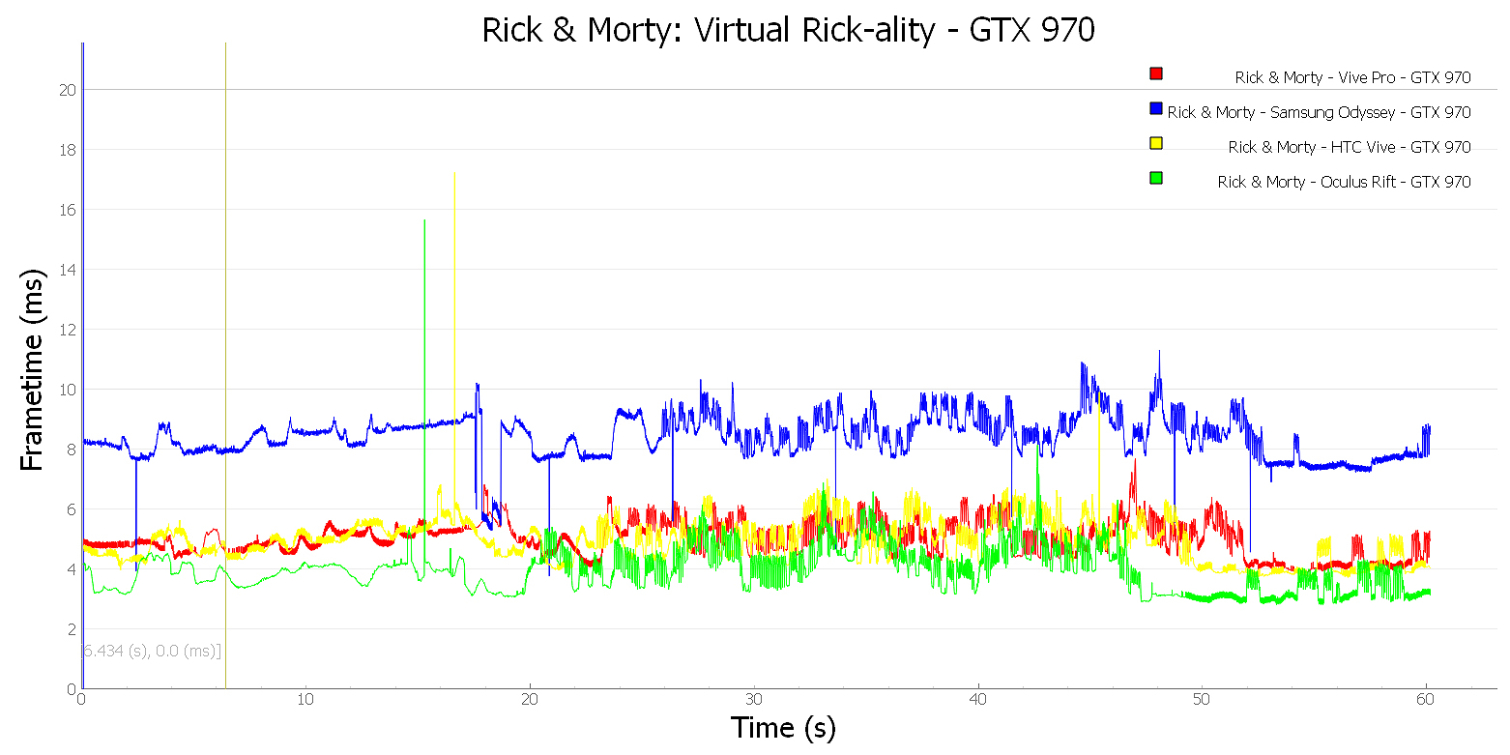
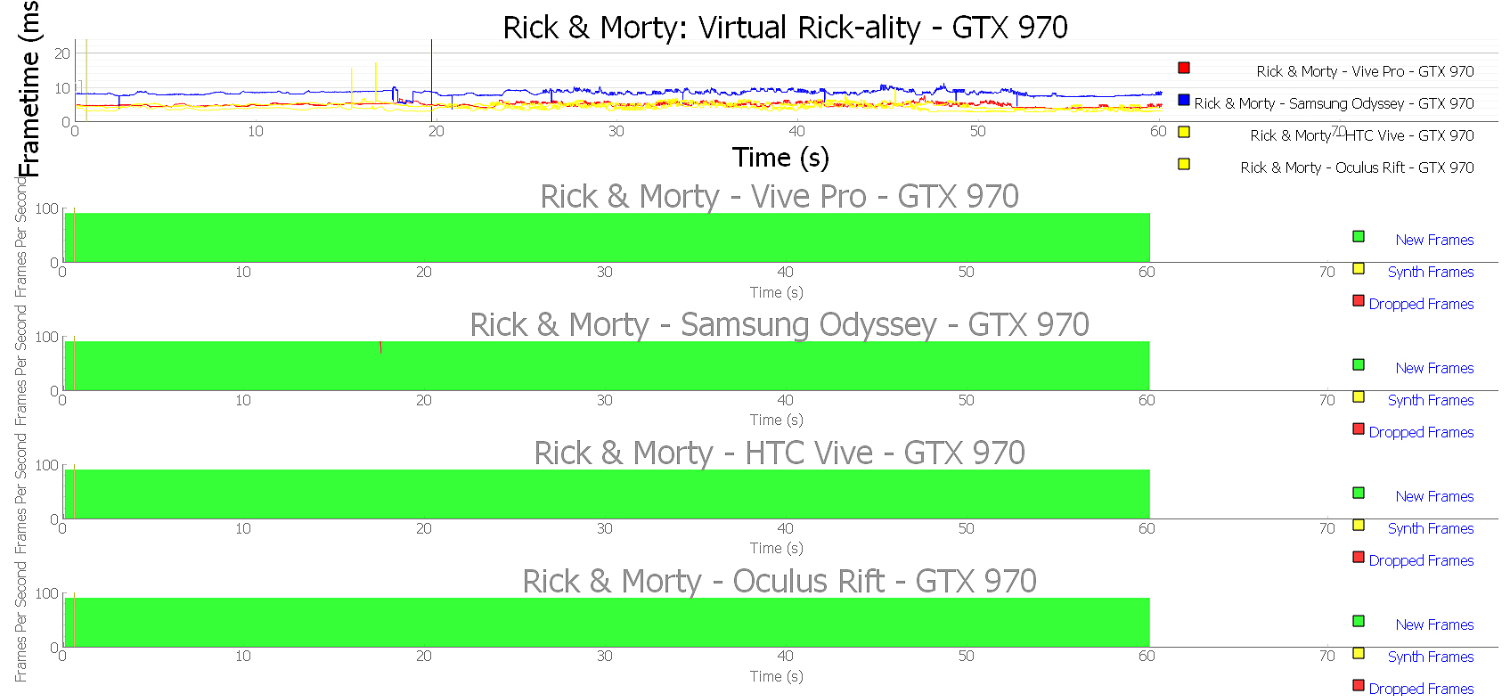
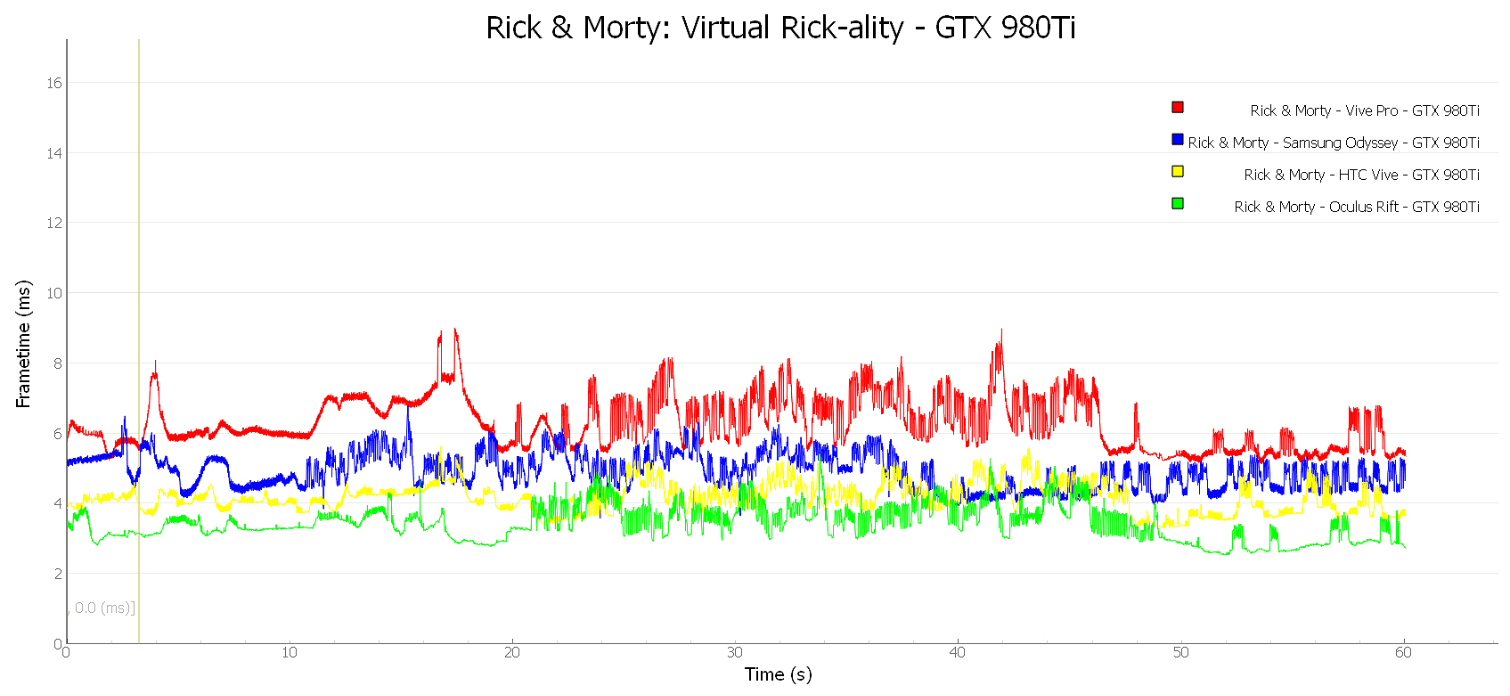
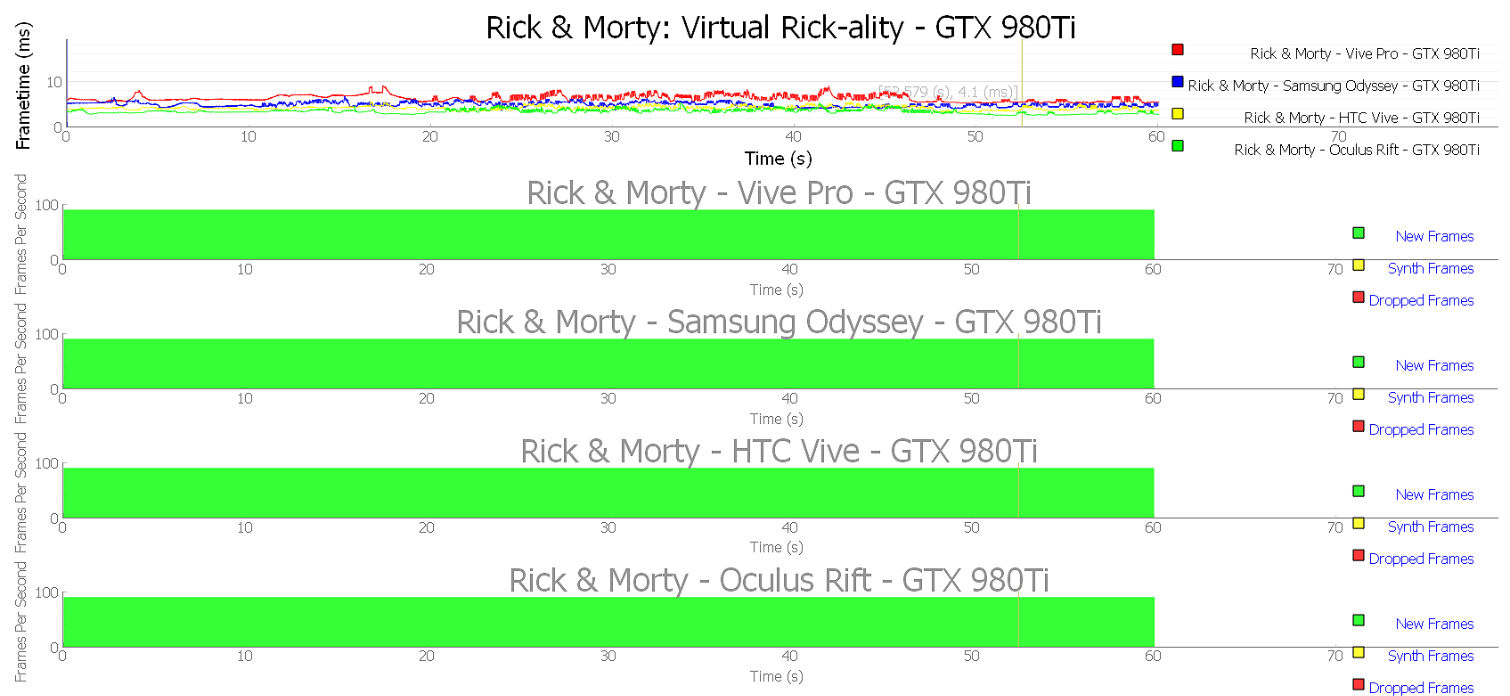
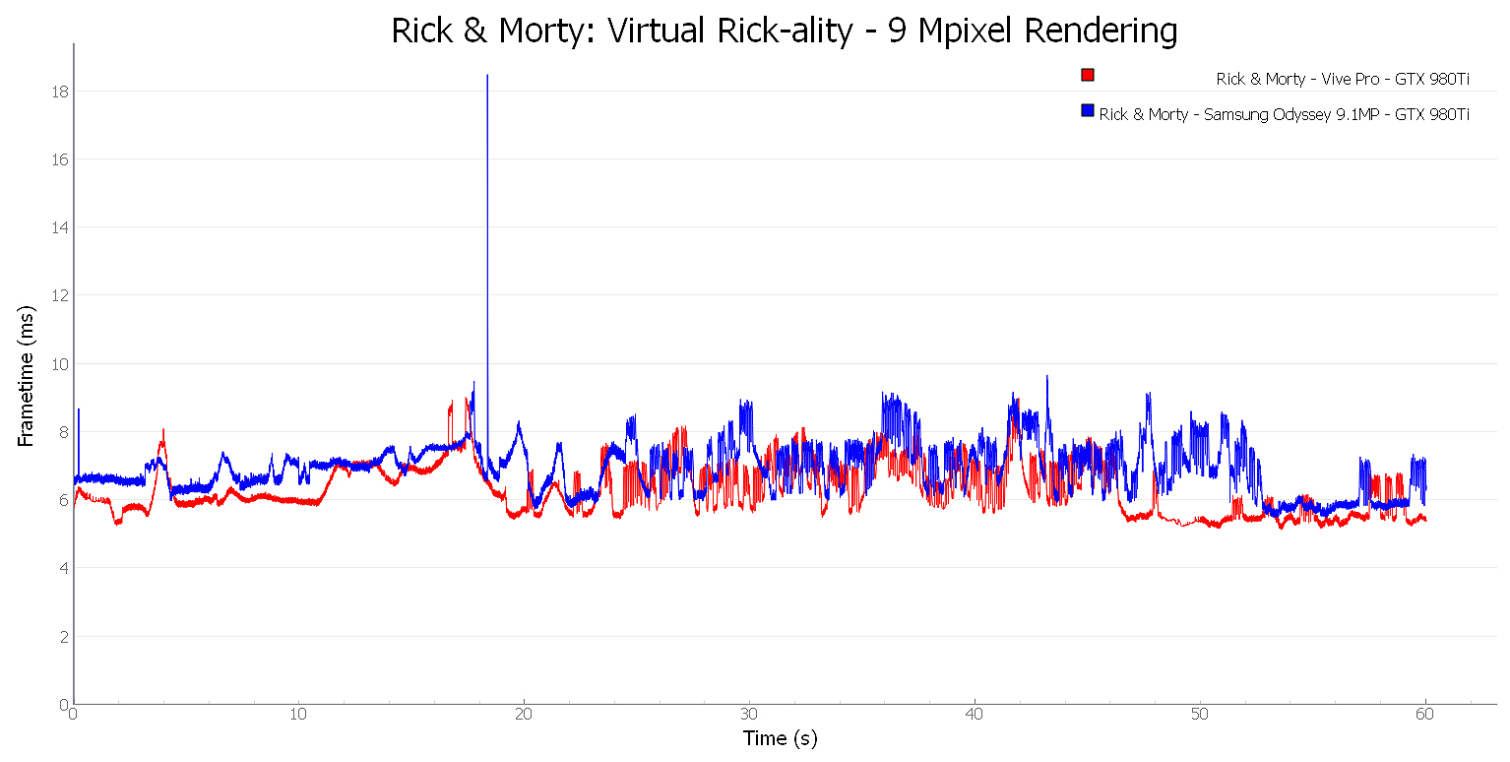
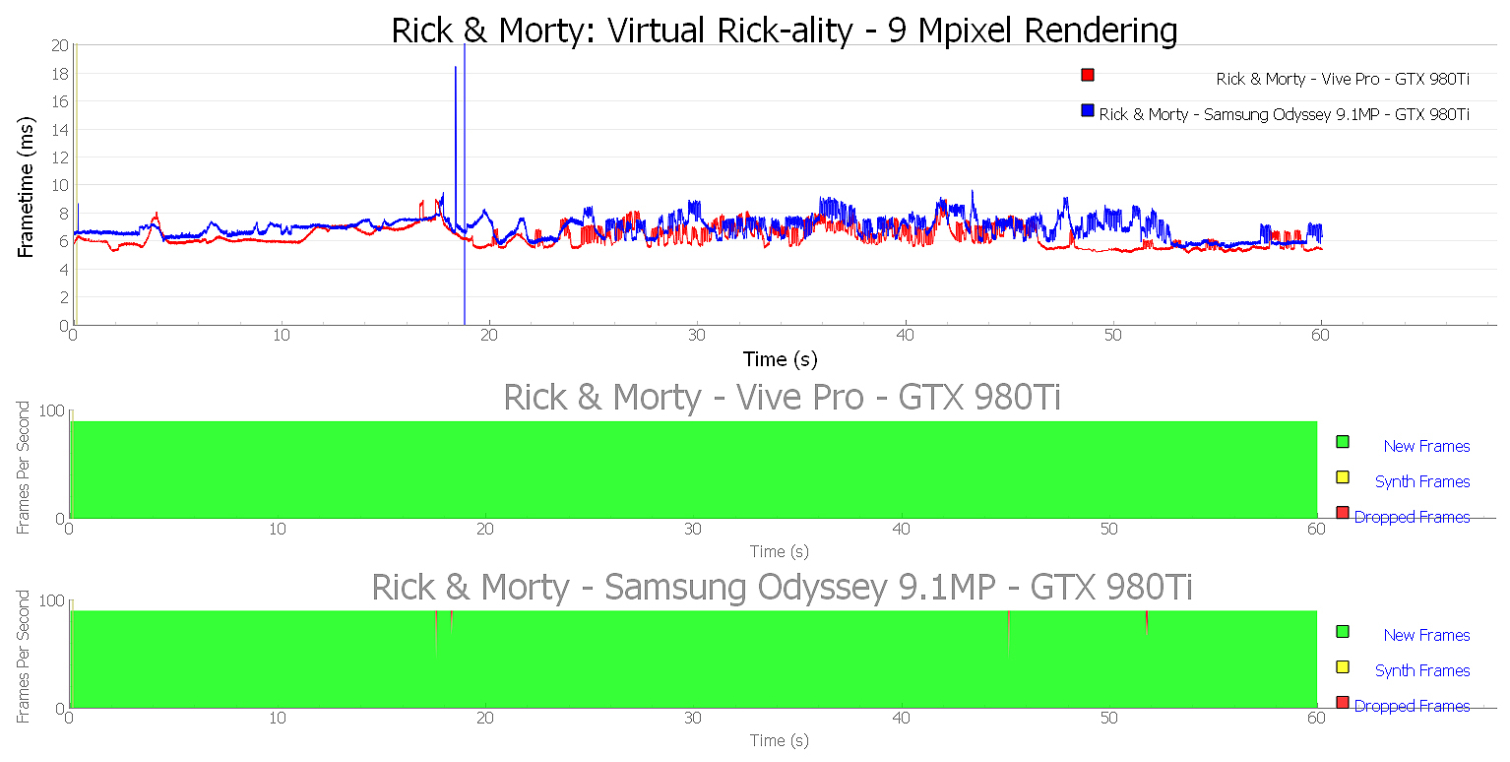
When we switched to the GTX 980 Ti, we were surprised to see that the tables had turned. The higher-power GPU kept the latency below 7ms in the Odyssey, while the Vive Pro flirted with 8ms and beyond. We’re not sure how the GTX 970 kept the latency so low.
We were surprised to see how consistent the performance results from the 9-megapixel comparison test were. The Odyssey headset gave the GPU a harder time than the Vive Pro, but the difference is frankly irrelevant, which means the Vive Pro doesn’t actually offer an advantage in visual fidelity in Rick & Morty.
Gorn
Gorn is another lightweight VR game, although it's not as well optimized as Rick & Morty. As you can see from the graphs, the frame timing in this game is not as consistent. Even with the GTX 980 Ti, the graph is all over the place. We even observed a handful of dropped frames in Gorn with both graphics cards, especially with the higher-resolution HMDs.
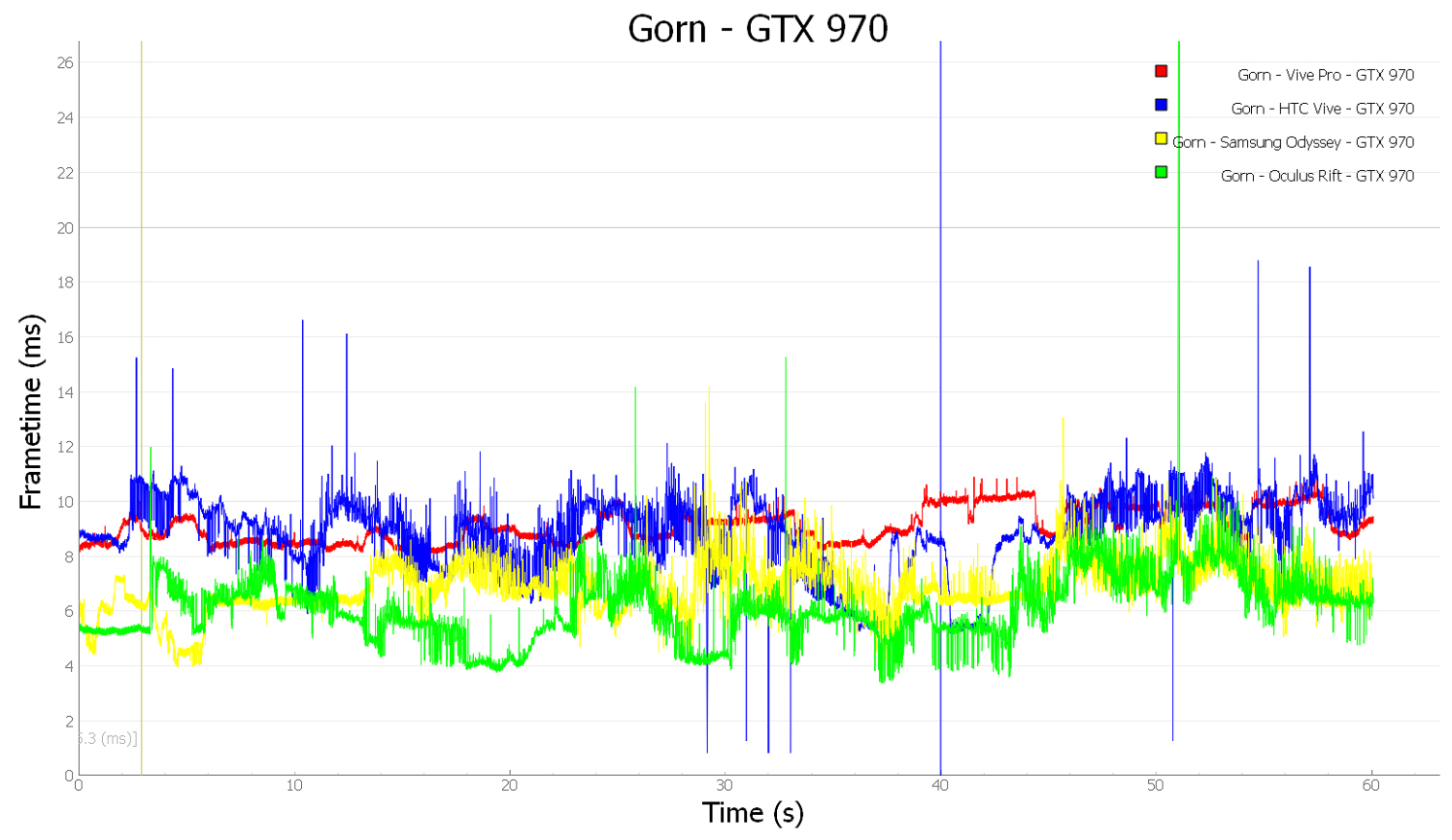
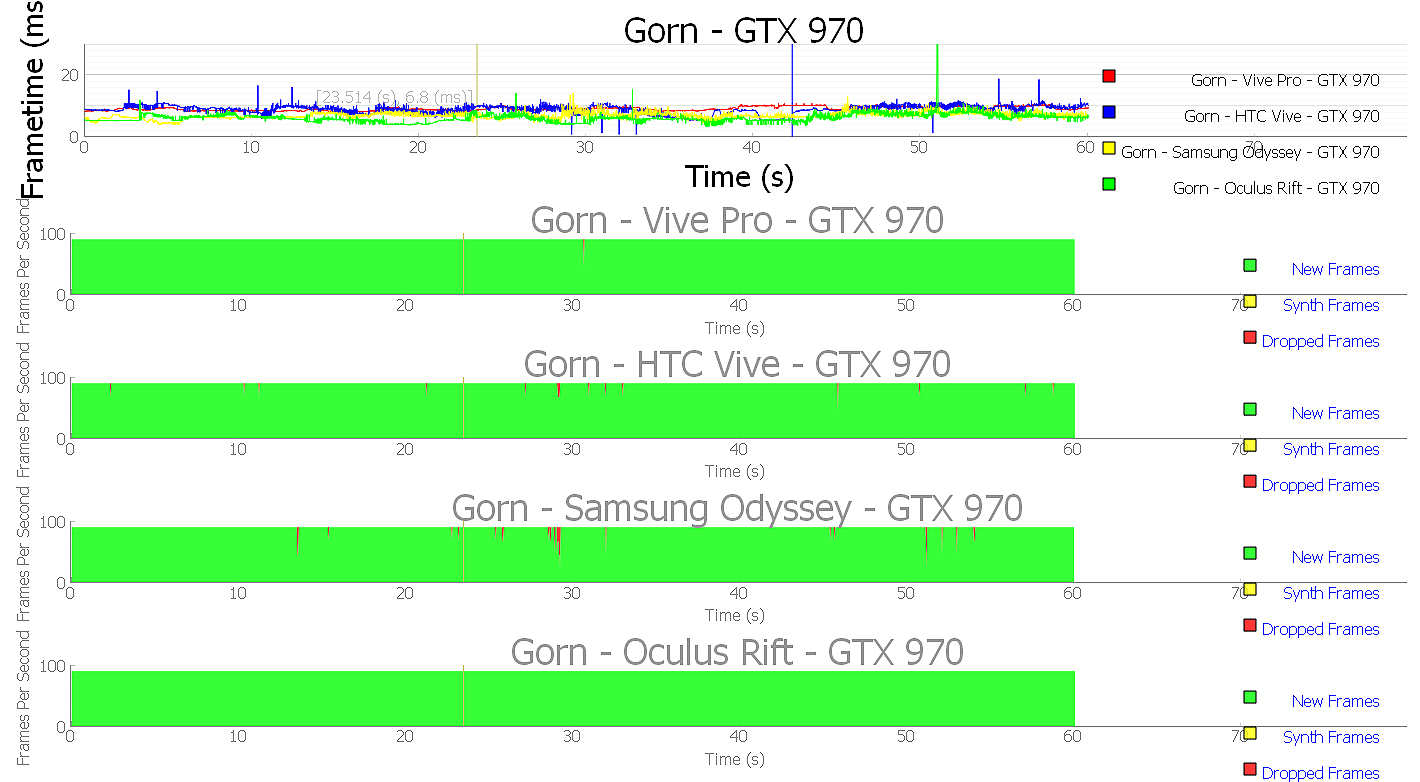
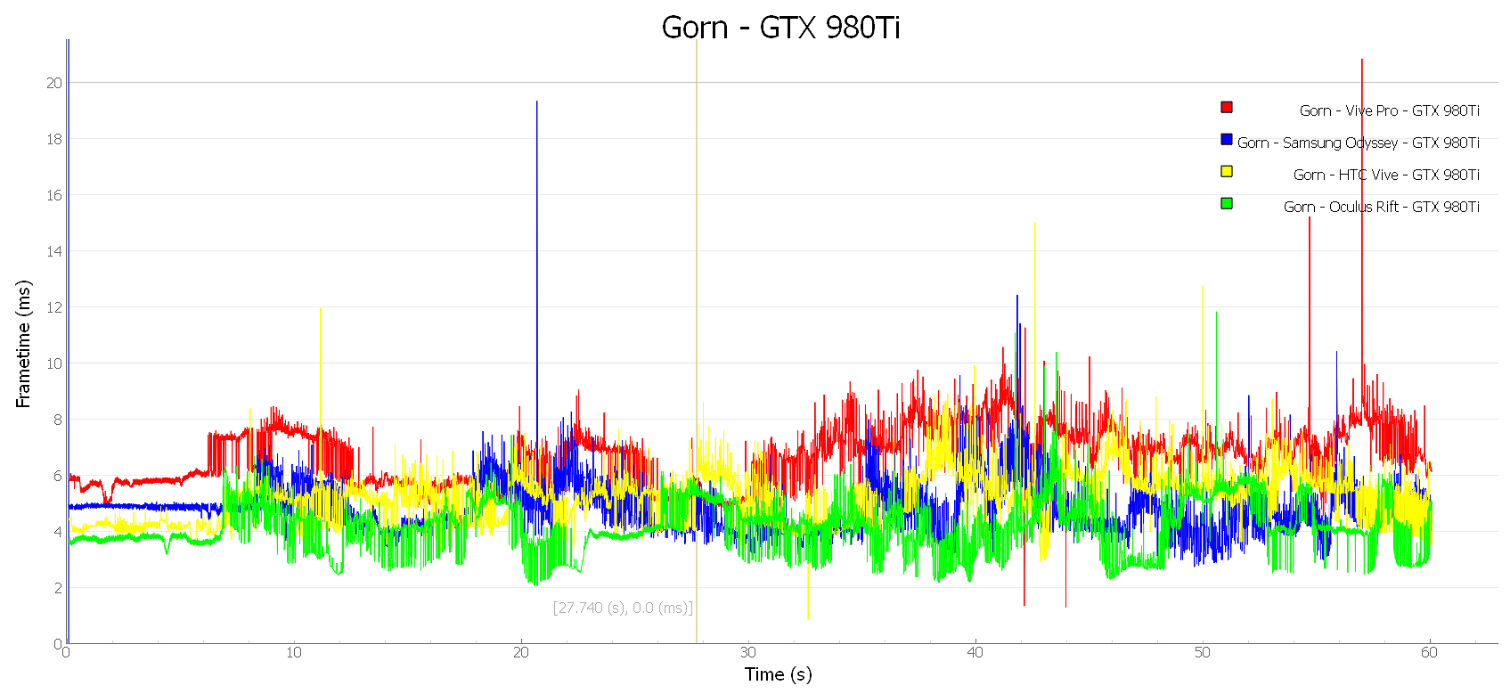
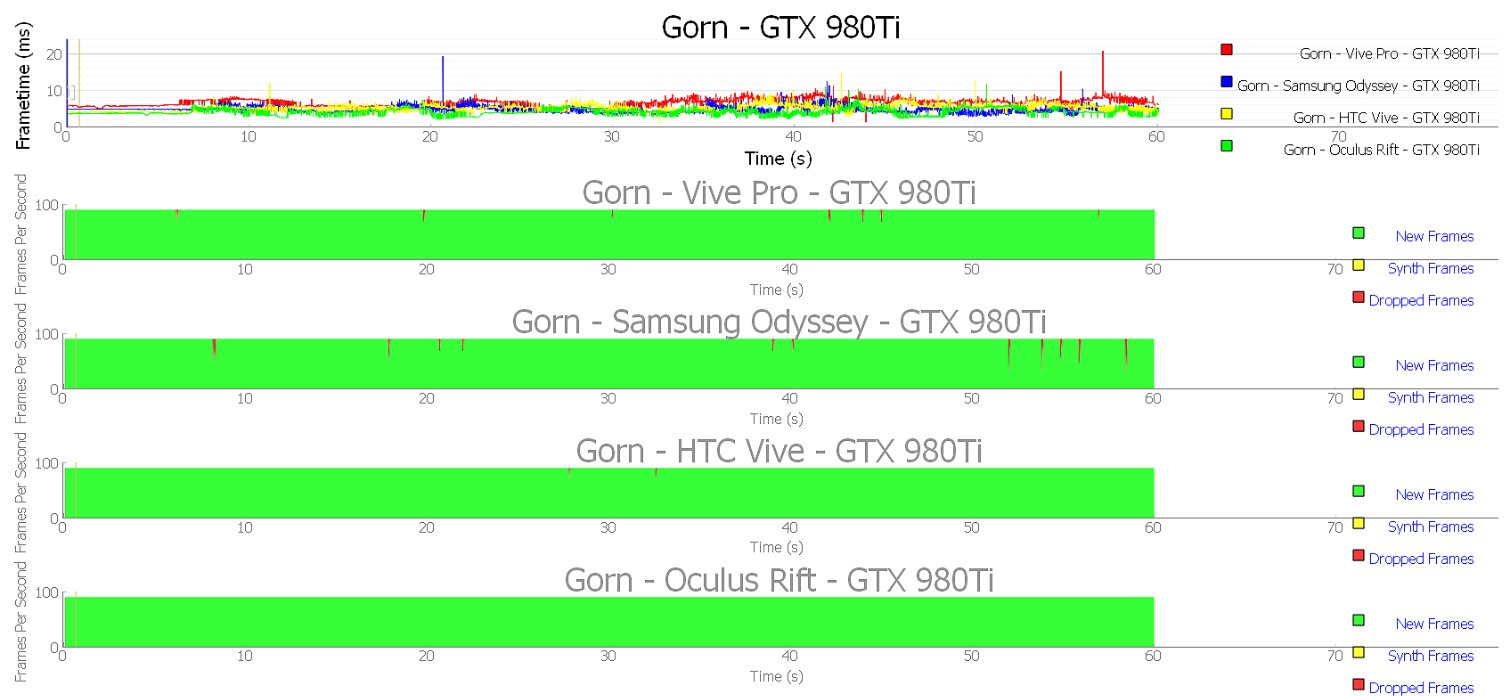
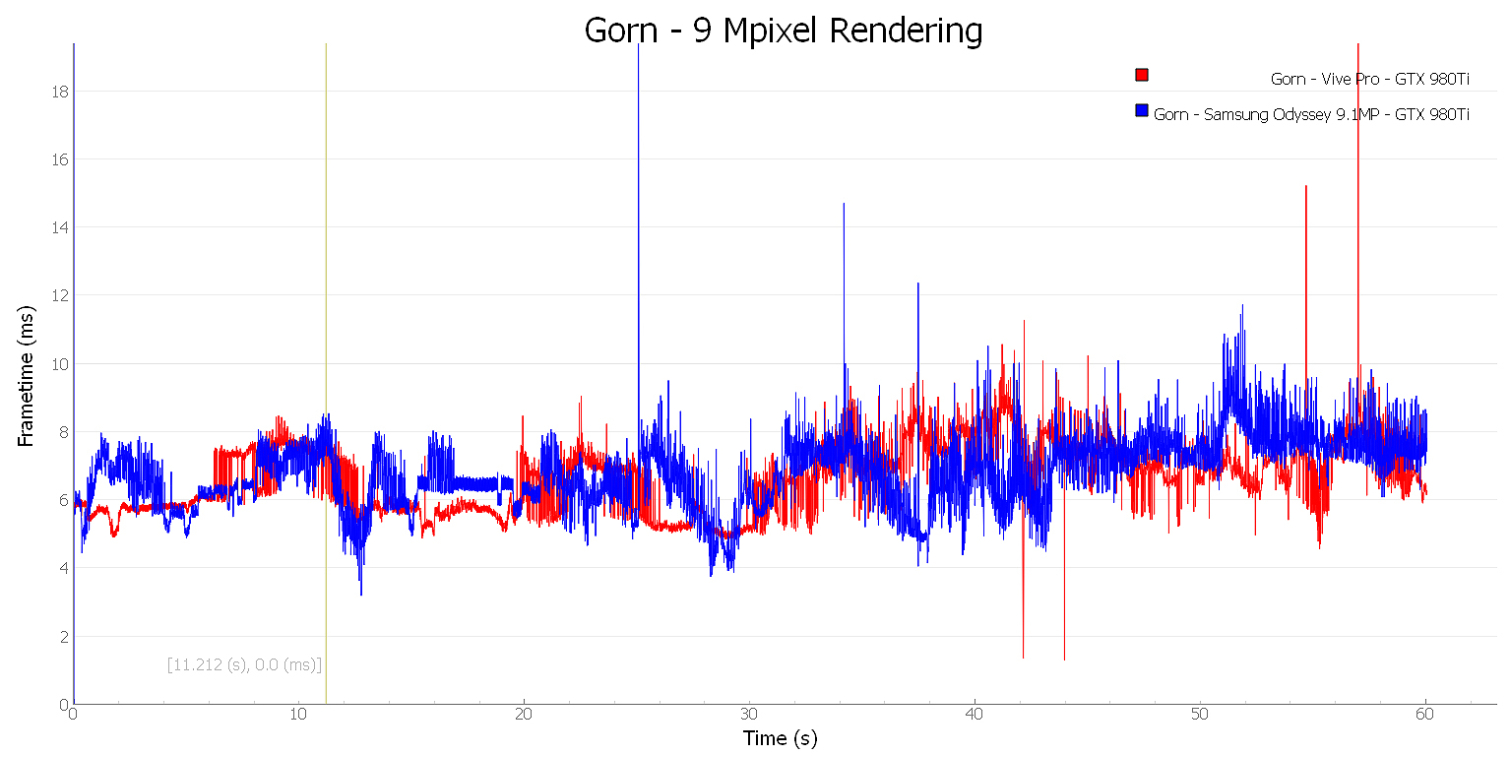
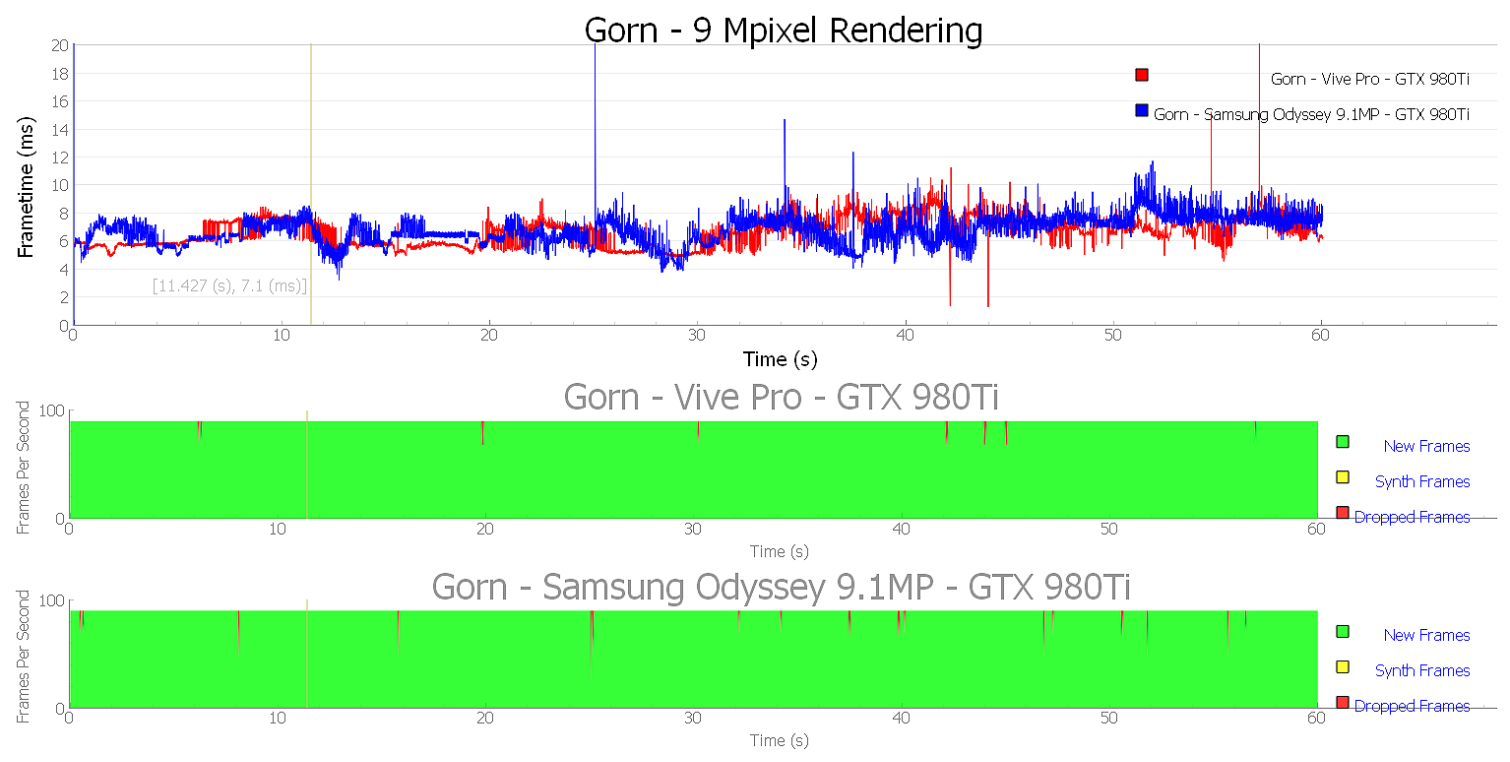
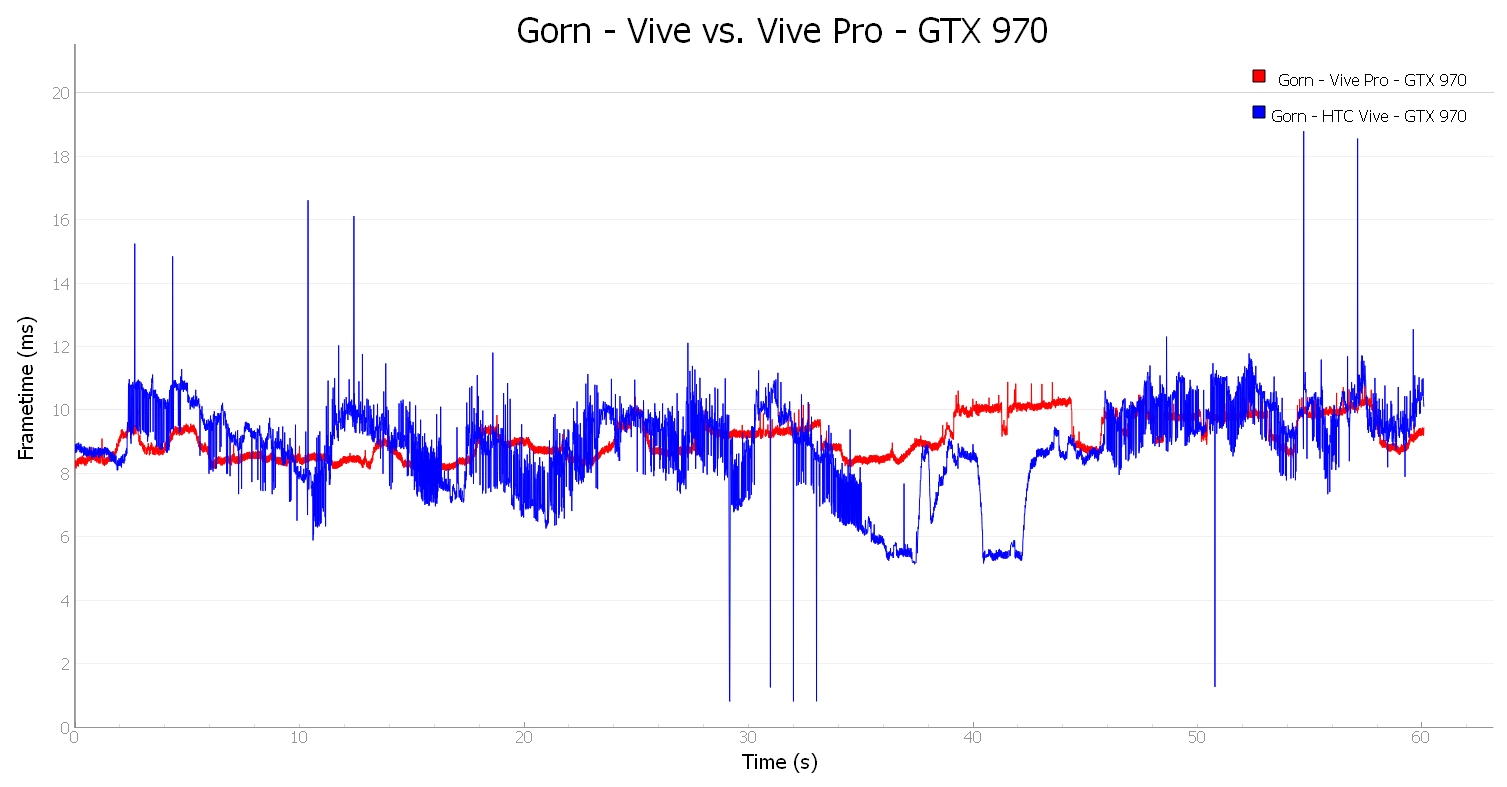
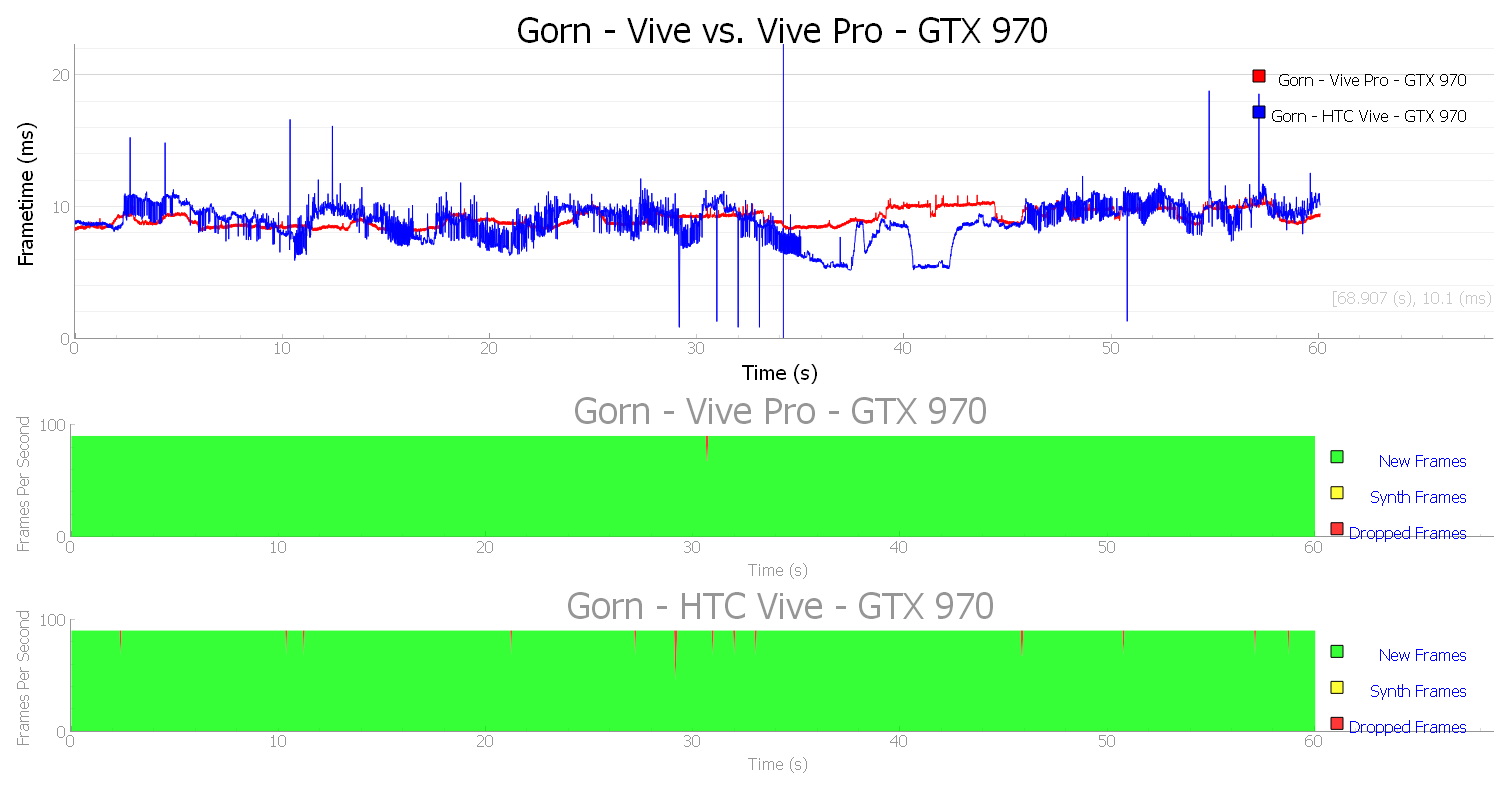
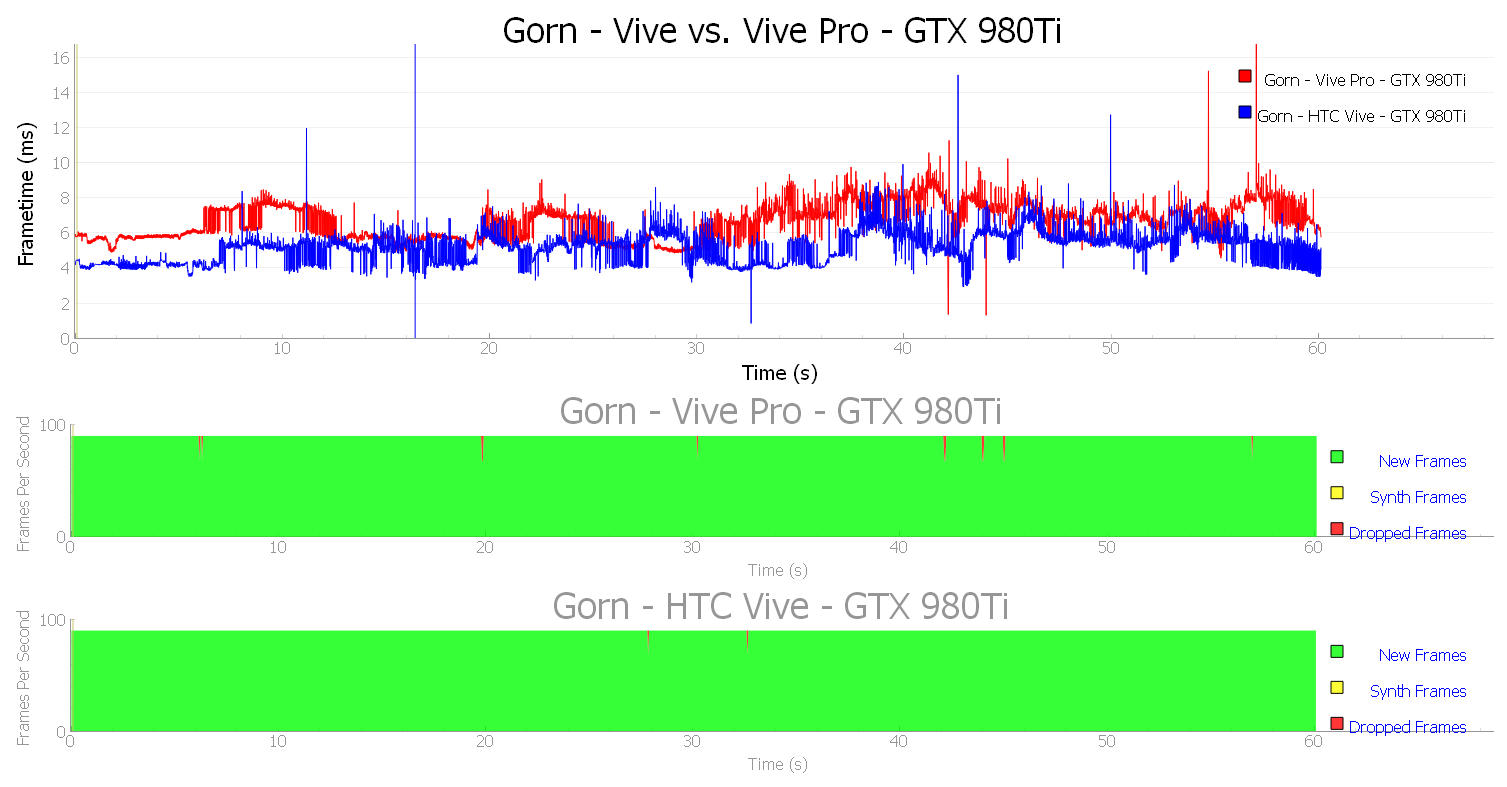

With both the Vive Pro and the Odyssey set with 9-megapixel rendering targets, the performance was consistent between the two headsets. We expected a performance deficit when using the Odyssey headset, but Valve updated SteamVR between our initial tests and the 1.8x render-target tests. So we could be seeing the fruits of recent optimizations.
Get Tom's Hardware's best news and in-depth reviews, straight to your inbox.
Arizona Sunshine
Arizona Sunshine is a more demanding title than Rick & Morty and Gorn. In fact, Vertigo Games added features to the title that it claims work best on high-end Intel i7 CPUs. Our test rig features an older yet still upper-class i7 processor, so we turned up all the goodies for our tests.
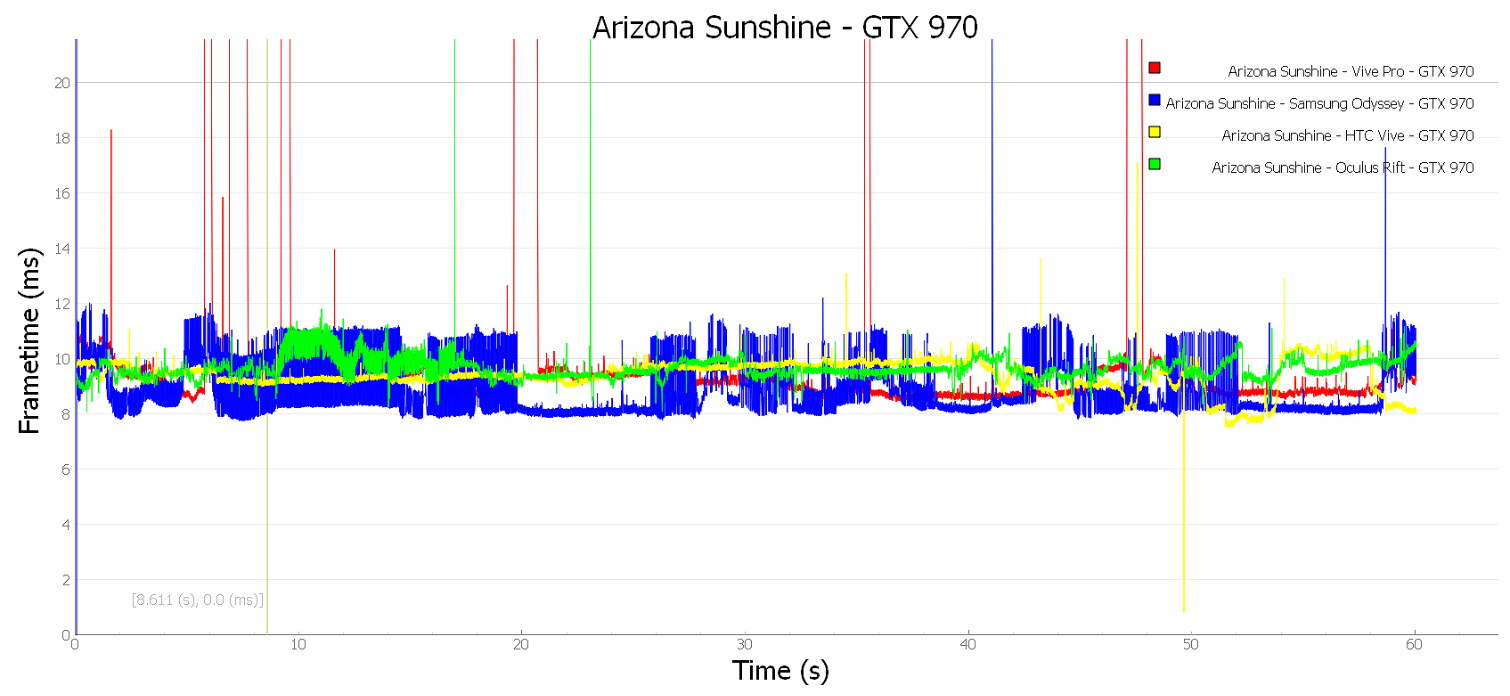
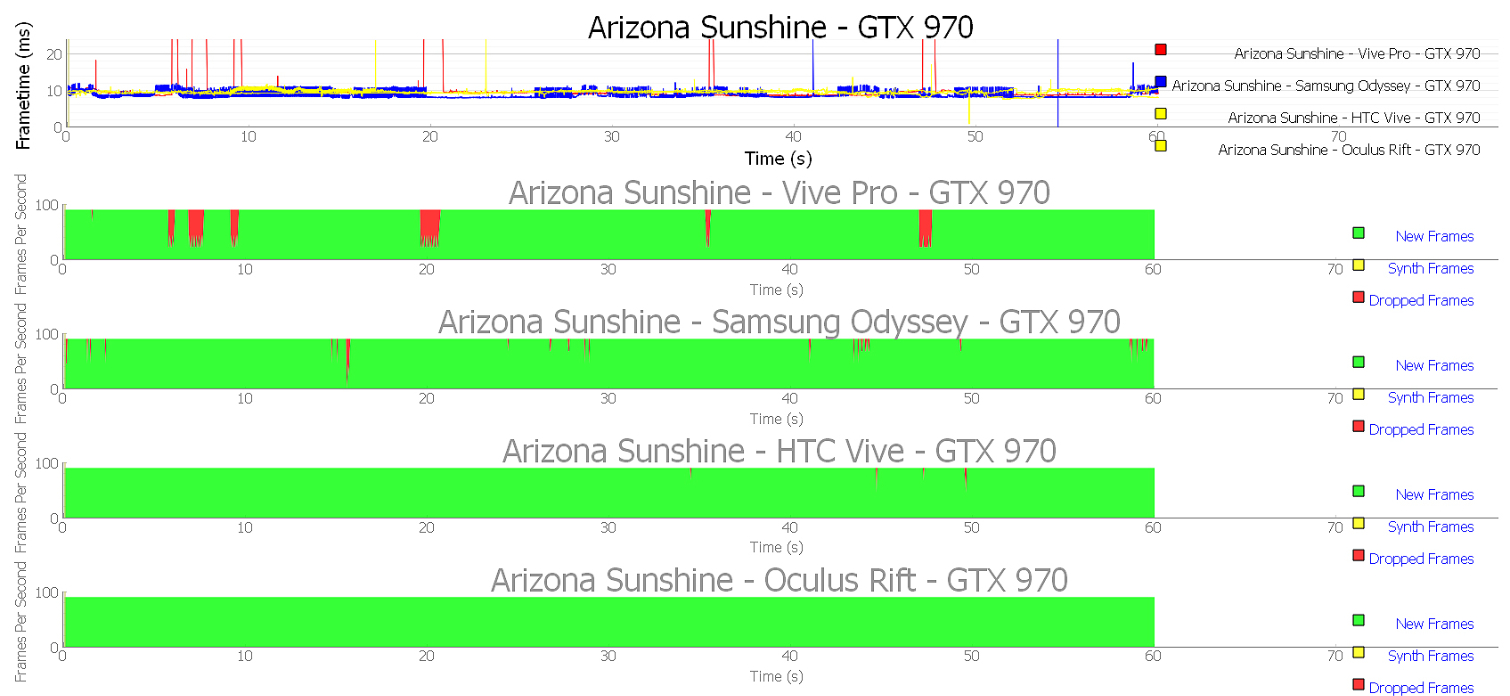
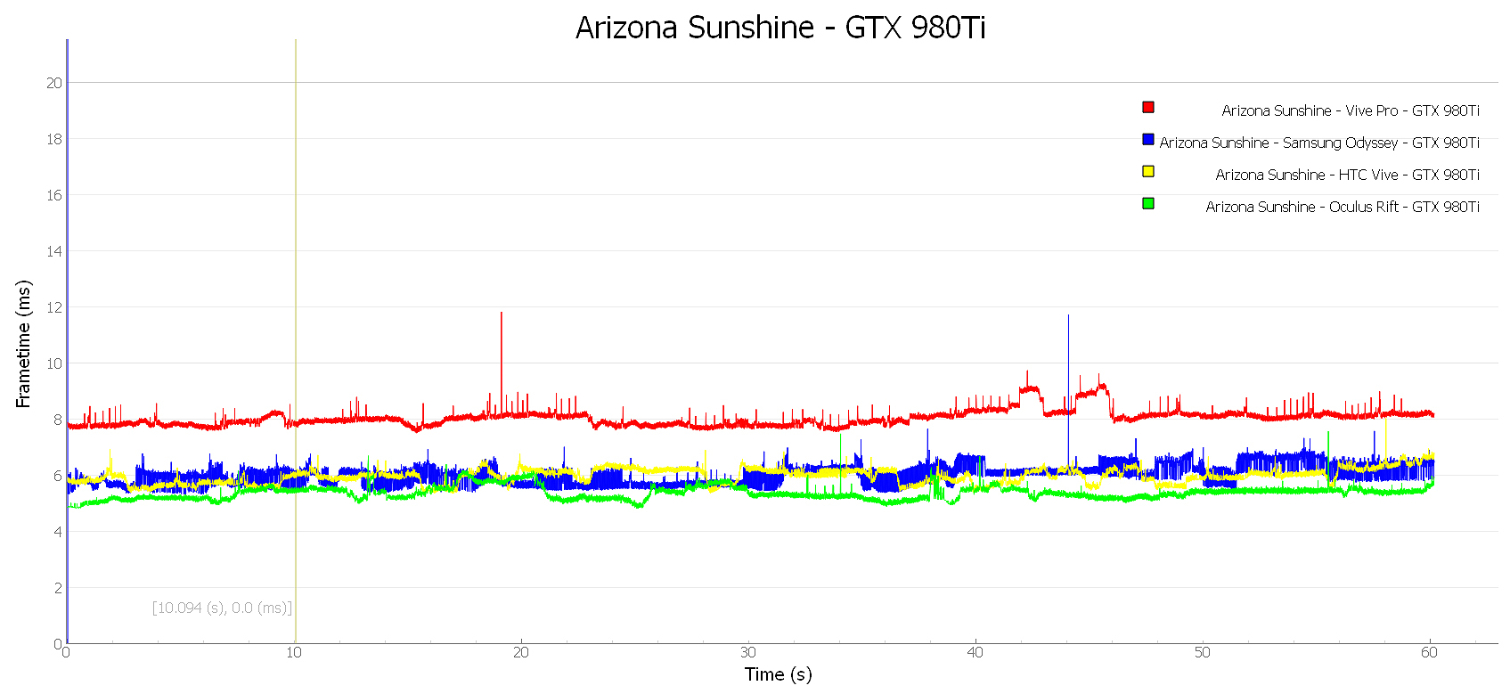
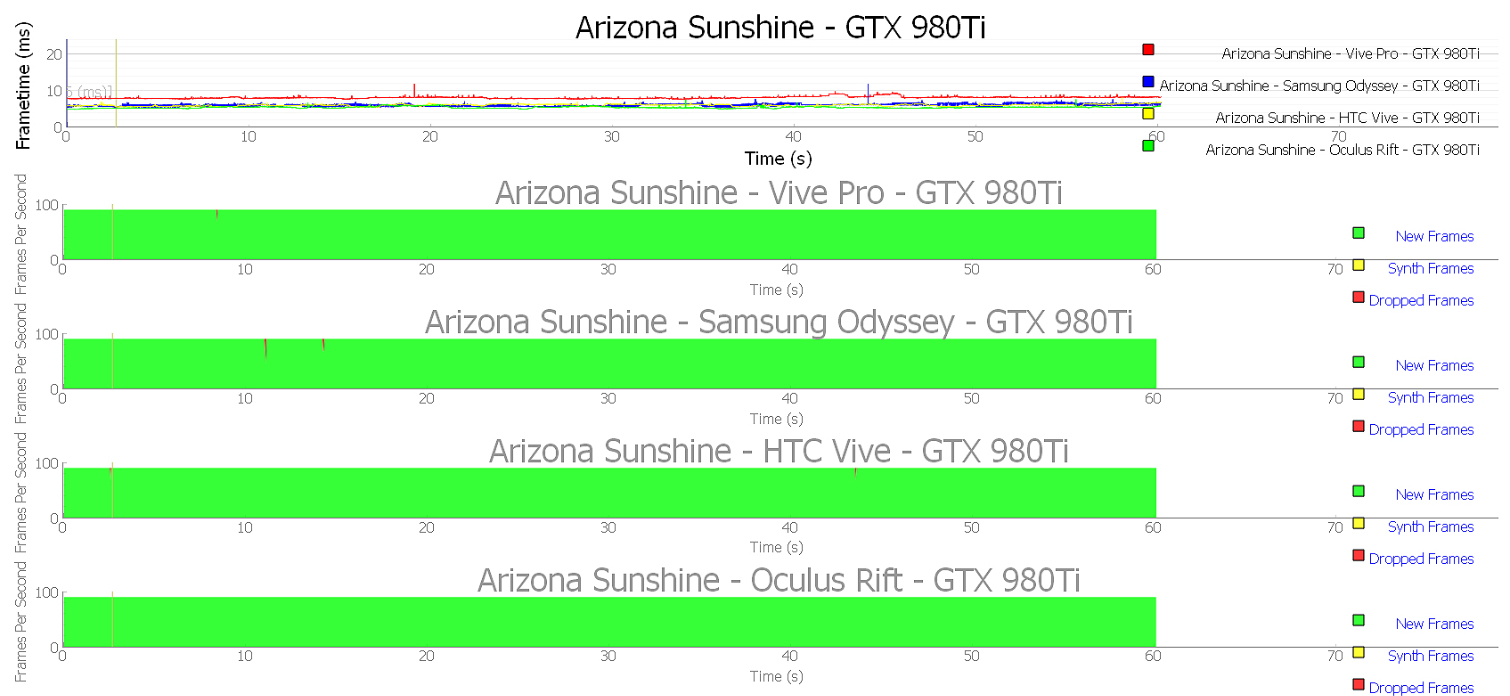
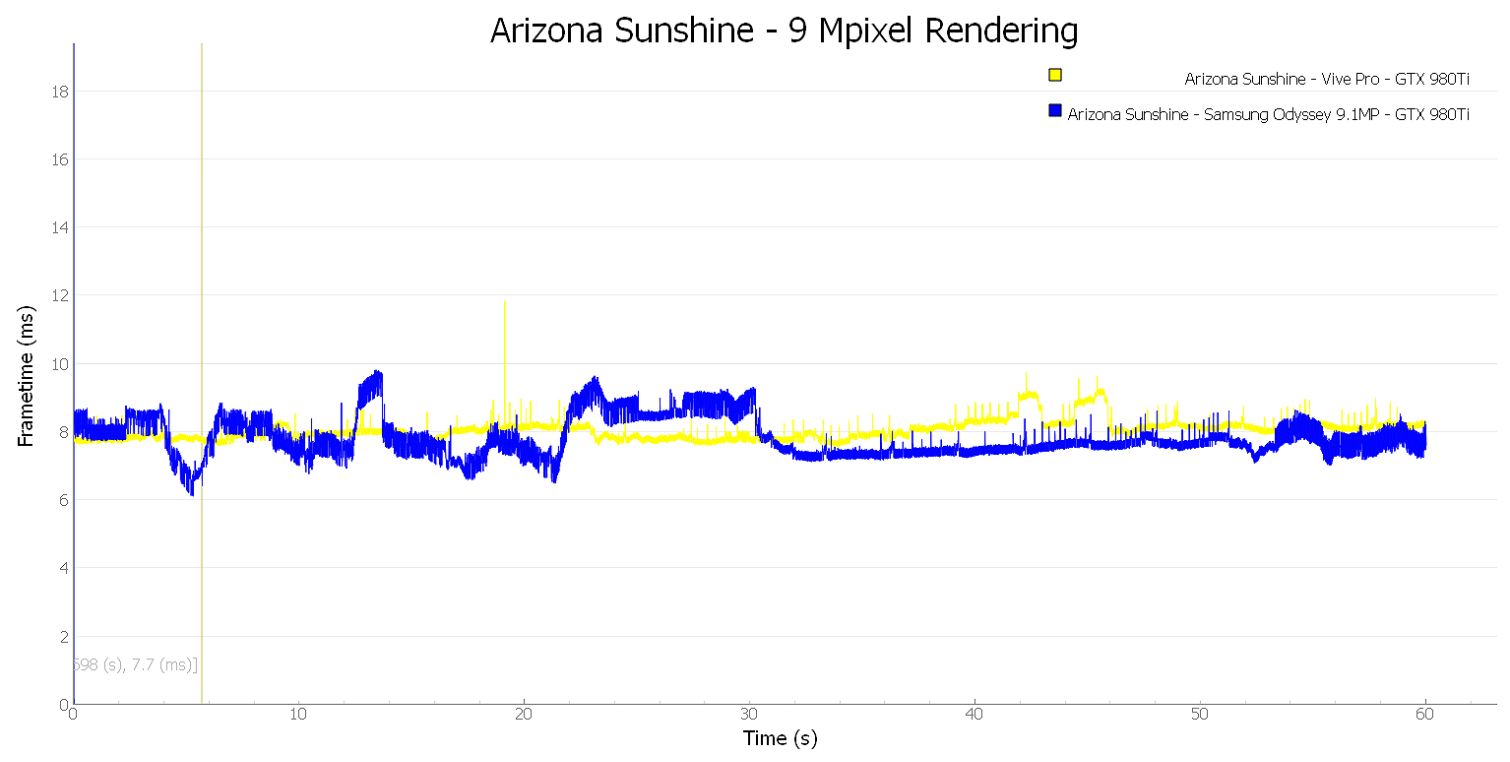
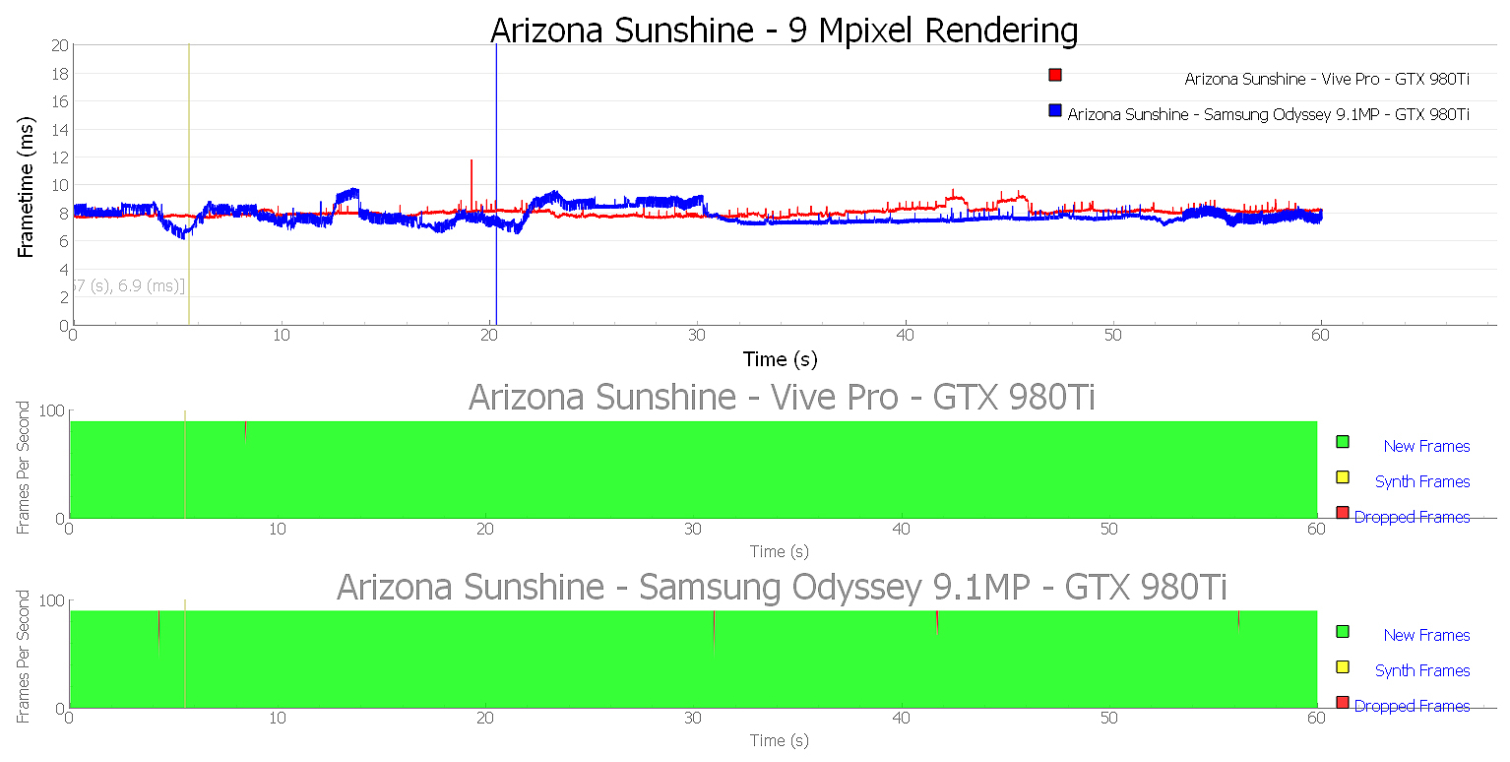
Our GTX 970 kept the latency below 10ms on the Vive and Rift with all the graphics settings dialed up. However, the higher pixel count of the new headsets pushed the limits of what the GTX 970 can handle. With the Odyssey headset, the frame timing was inconsistent. But with the Vive Pro, the experience was much worse.
Note that the graph shows that we experienced high dropped frames several times in our 60-second test. Those were moments when the chaperone came into view. Our GTX 970 was unable to render the game and provide basic chaperone information simultaneously.
We didn’t observe any issues when we used the GTX 980 Ti to drive the headsets.
Serious Sam VR: The Last Hope
We can’t say that we were surprised with the results from our Unity games, but we wouldn’t call the results predictable, either. We would describe the performance in Serious Sam VR, though, as predictable. We already know that Serious Sam is well optimized, and our GTX 970 delivers low latency and stable frame rates with the Oculus Rift and HTC Vive alike. The Odyssey headset demonstrated some performance issues, but Windows MR headset support on SteamVR is in beta, so we didn’t expect perfect results there.
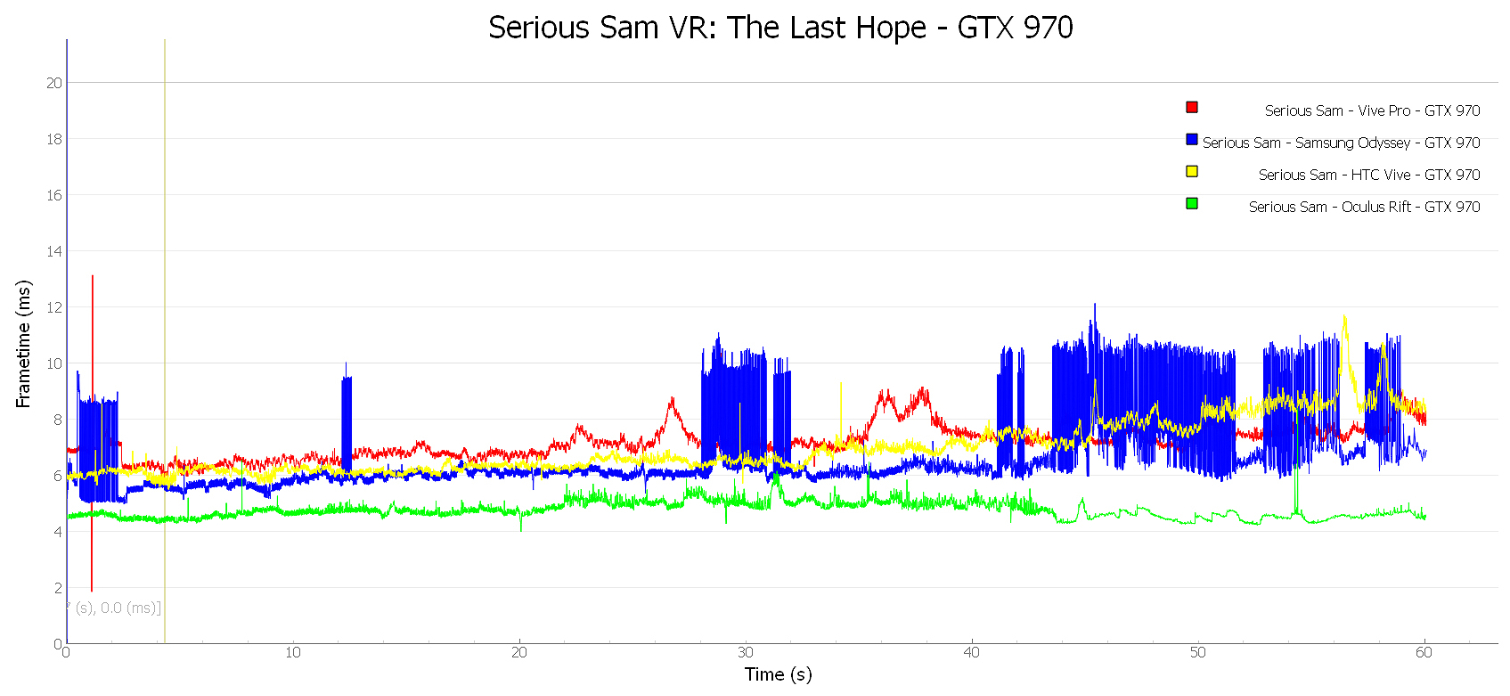
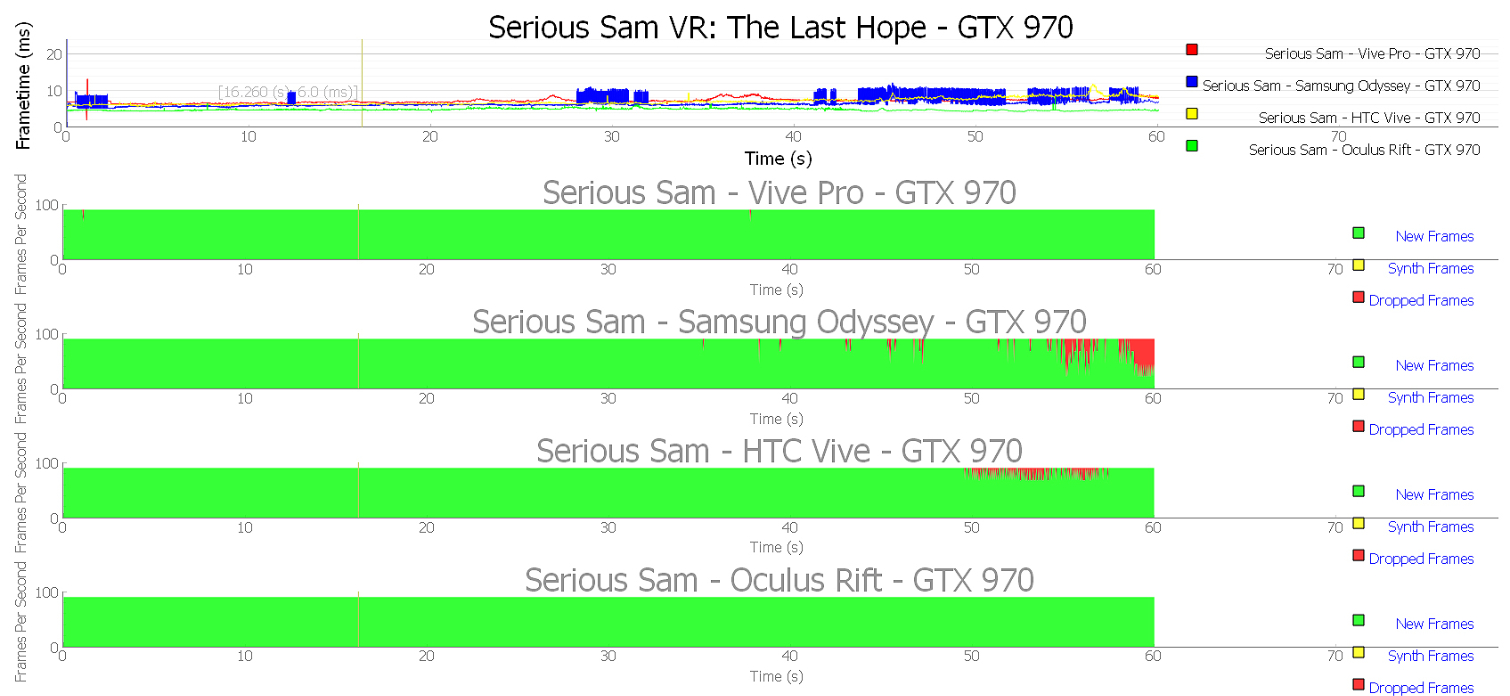
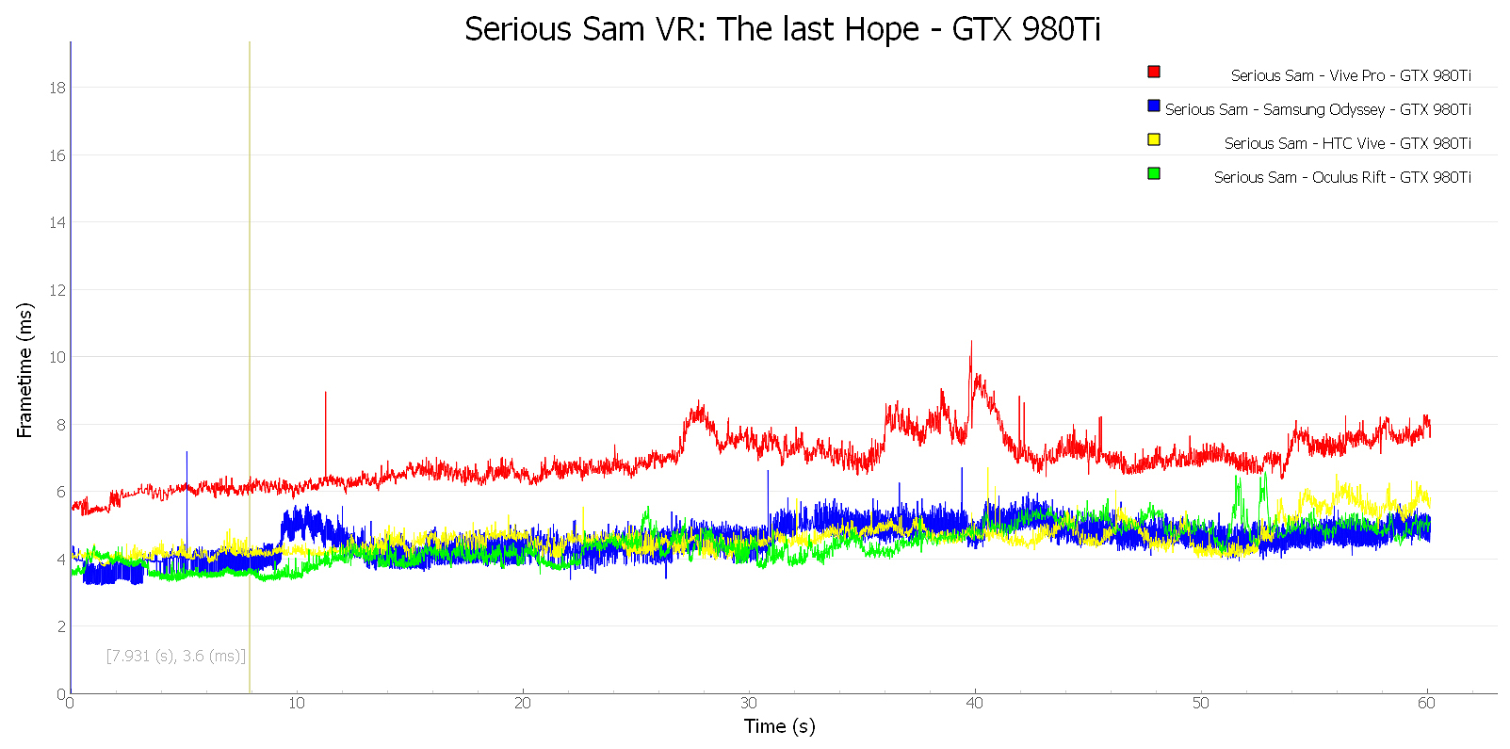
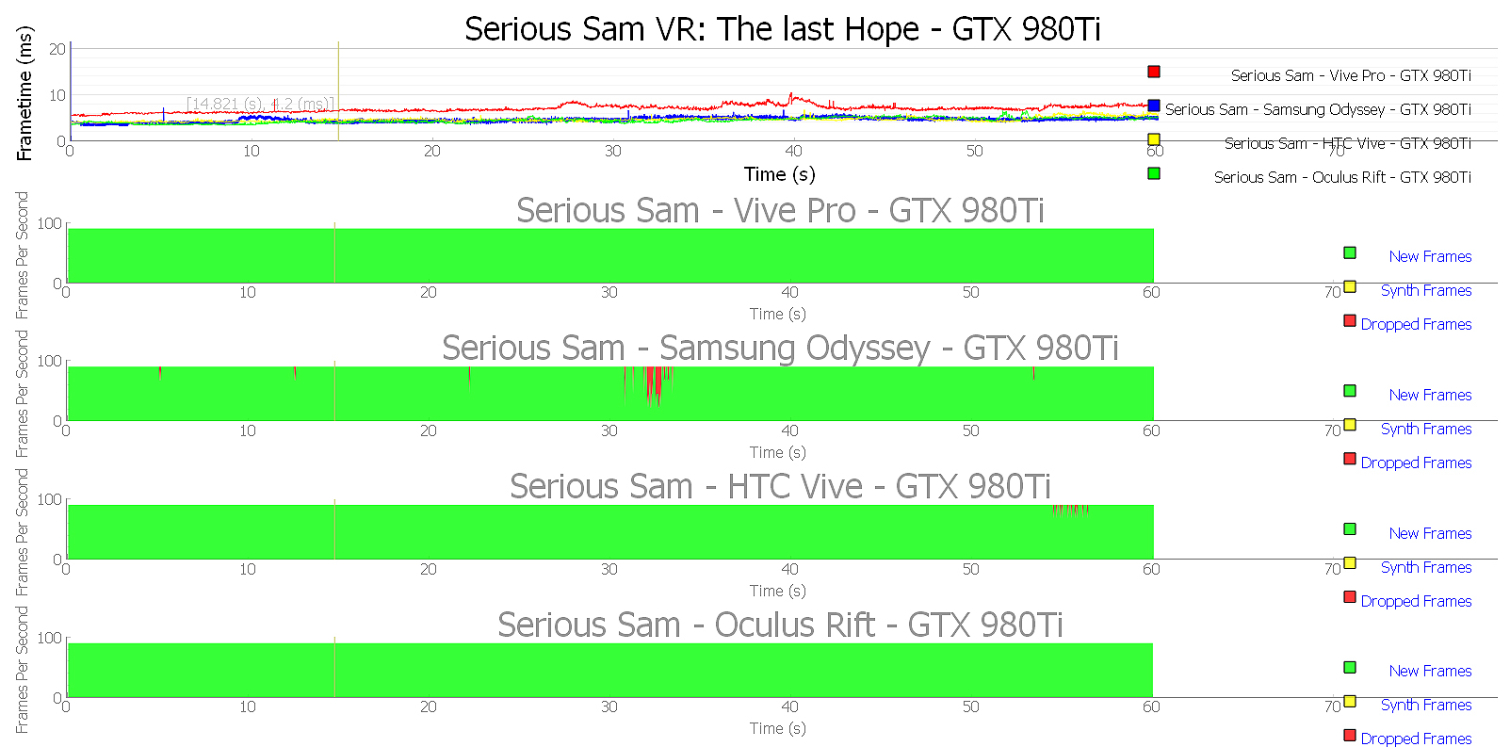
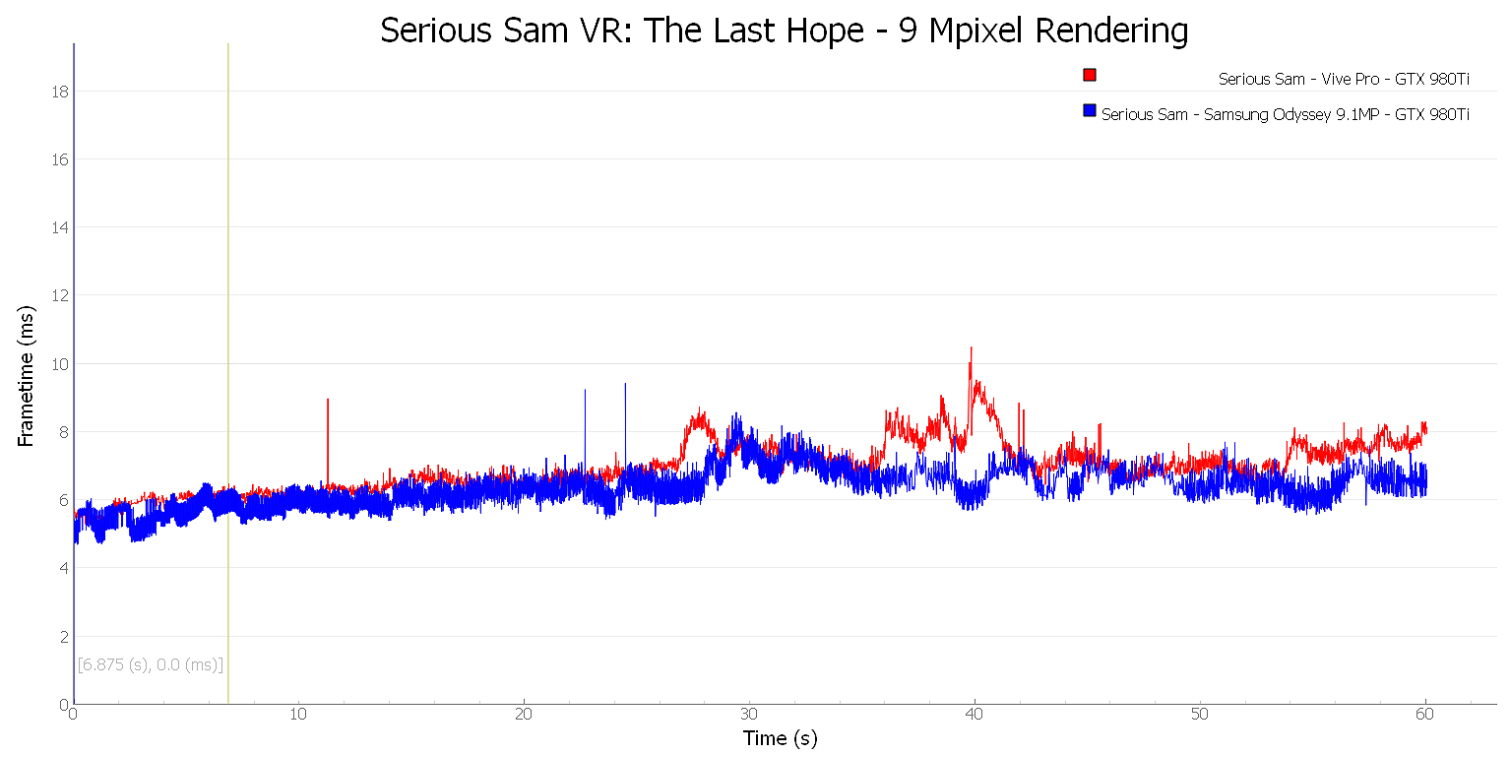
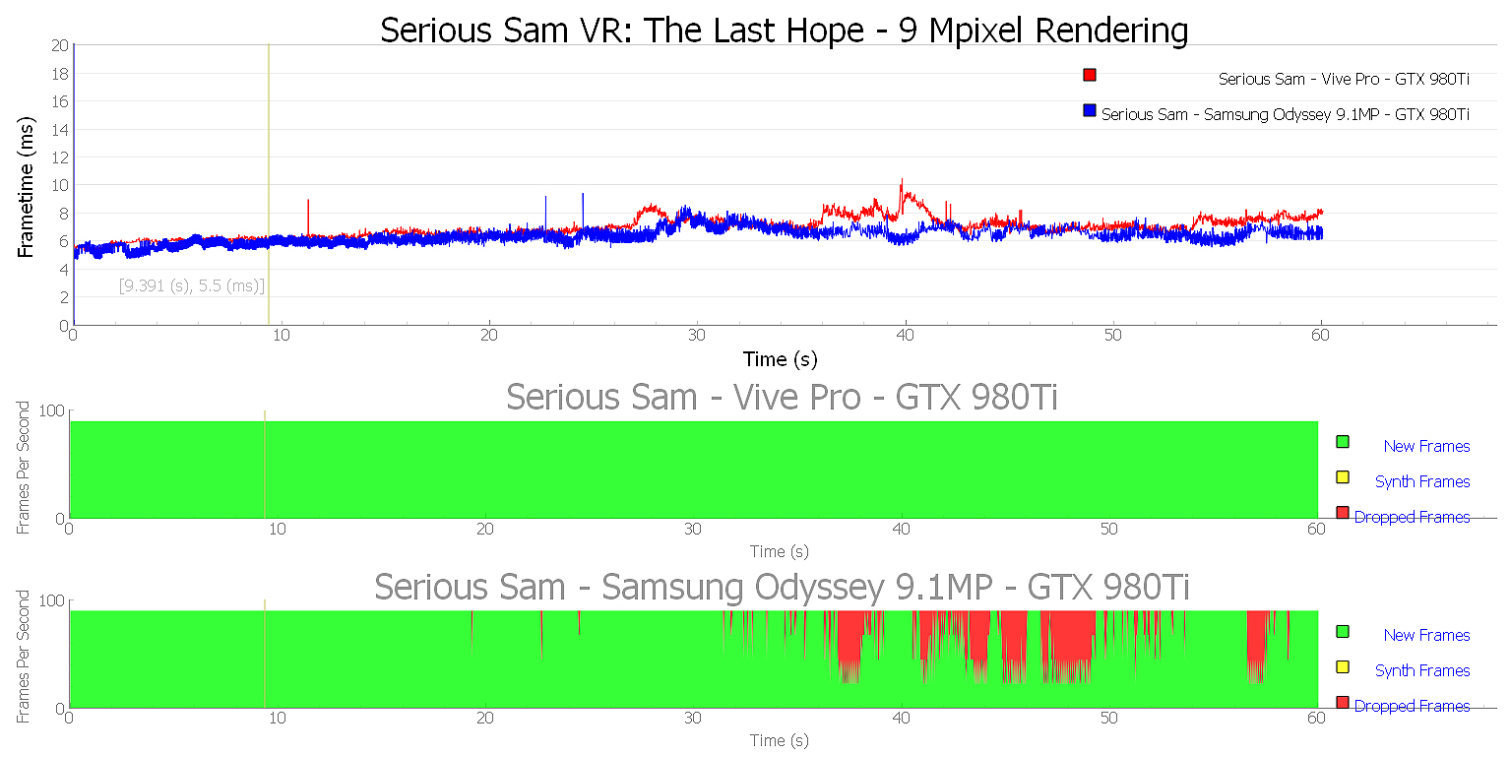
The Vive Pro results surprised us, though. Despite the 9-megapixel-per-second workload, the GTX 970 kept the latency below 9ms for the whole test. The GTX 980 Ti kept the latency of the Rift, Vive, and Odyssey well below 6ms, but the Vive Pro pushed the latency up beyond 7ms.
With both headsets on level playing fields, the frame timing is more stable with Vive Pro, but with slightly more latency.
Island 359
Island 359 is the heavy hitter of our test suite. The game is optimized to deliver smooth frame rates for an HTC Vive from a GTX 970, but Cloudgate pushed the limits to get there. With our GTX 970, we can run Island 359 at high settings on our Vive, and we get excellent performance, with few dropped frames and no major hitches. However, a close look at the graphs reveals that our GPU just barely managed to keep the frames coming in under the wire.
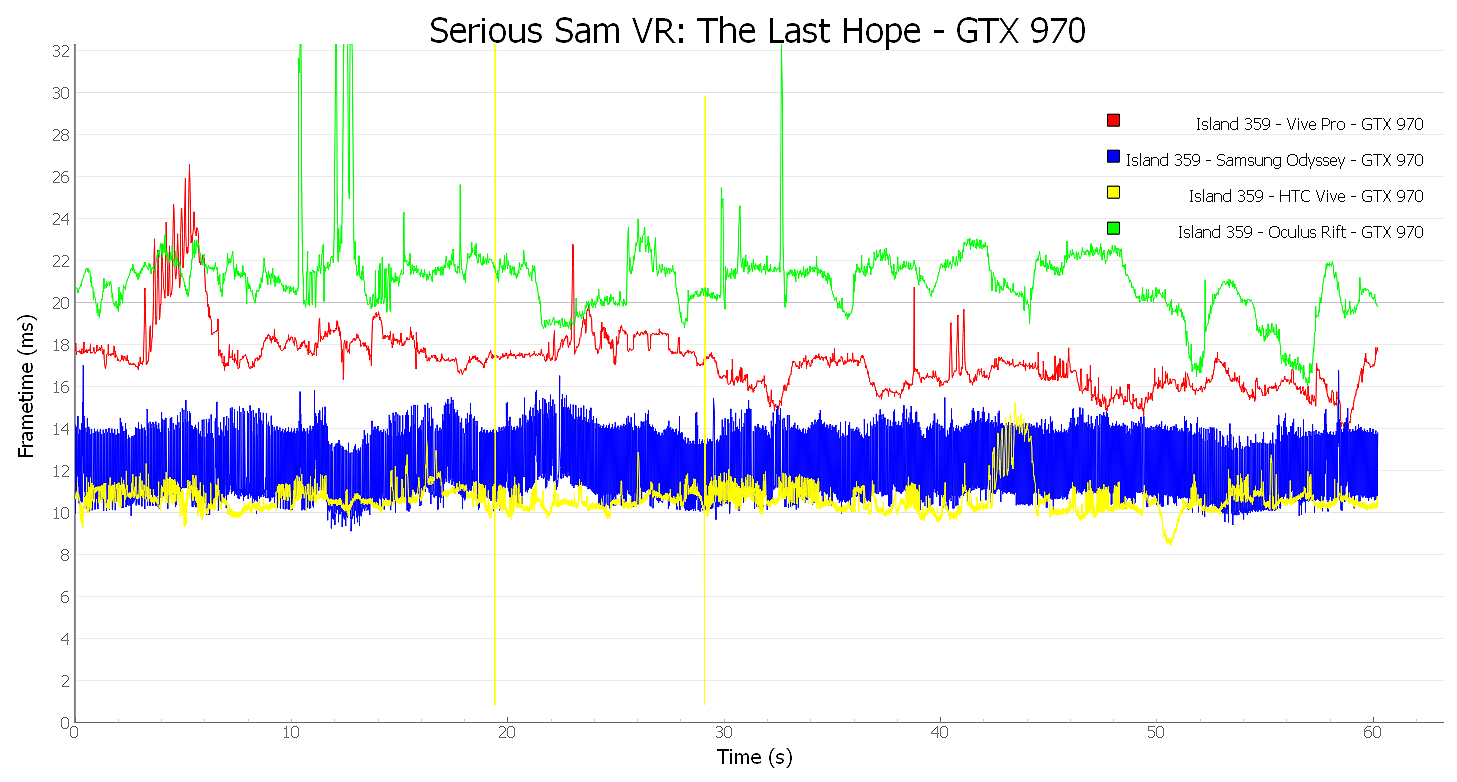
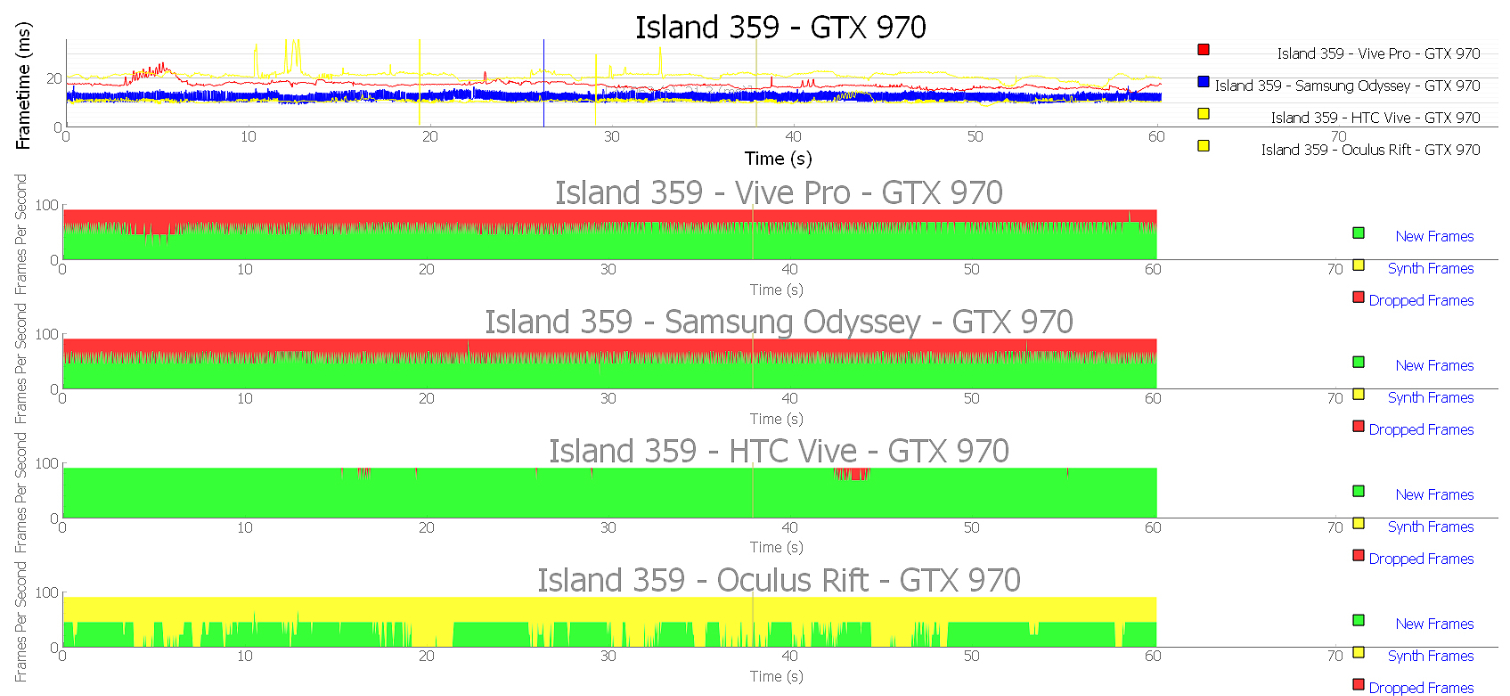
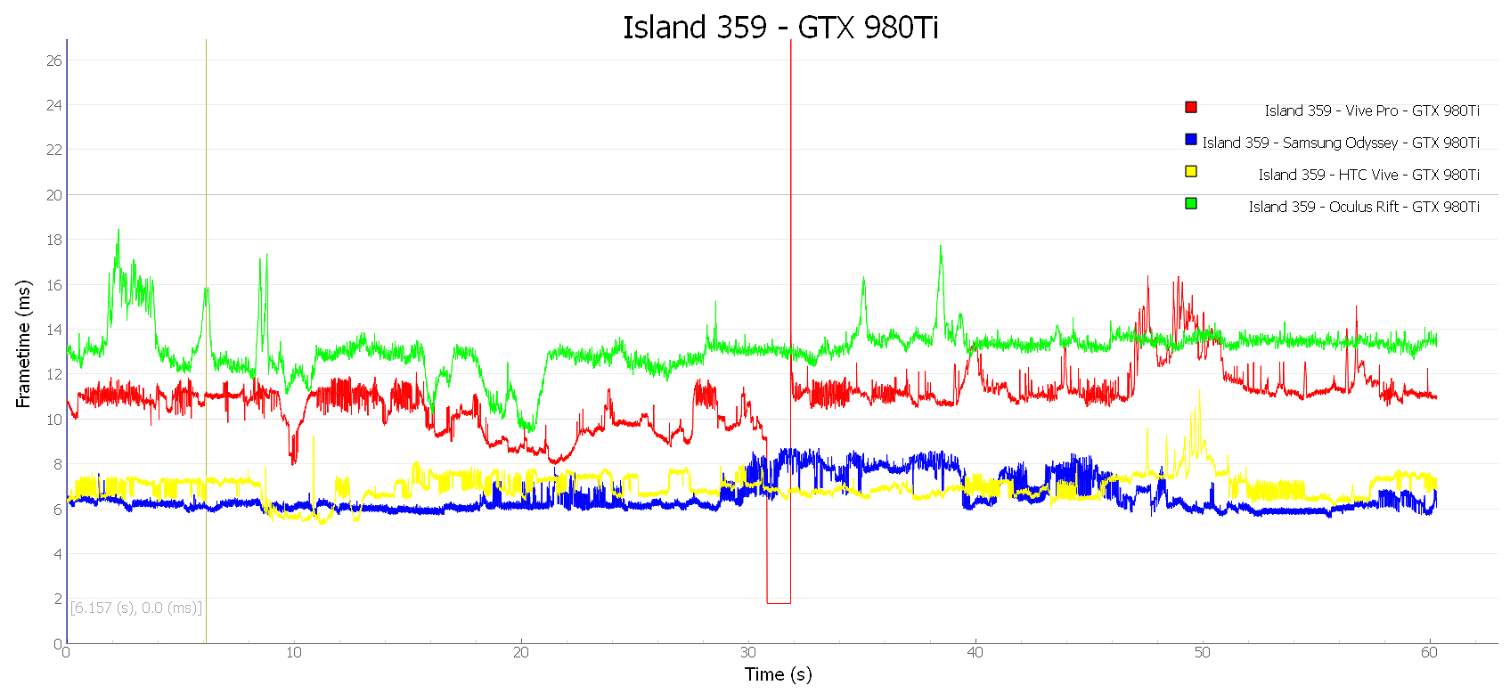
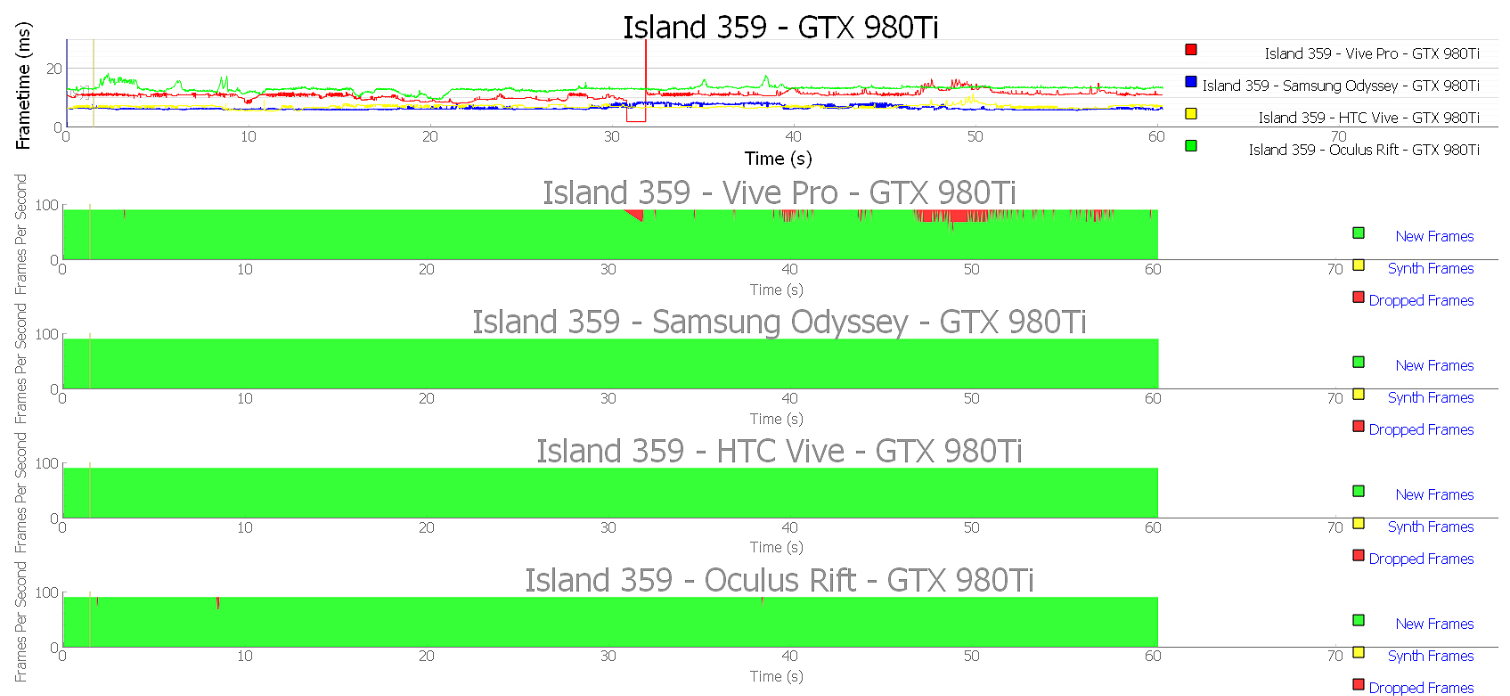
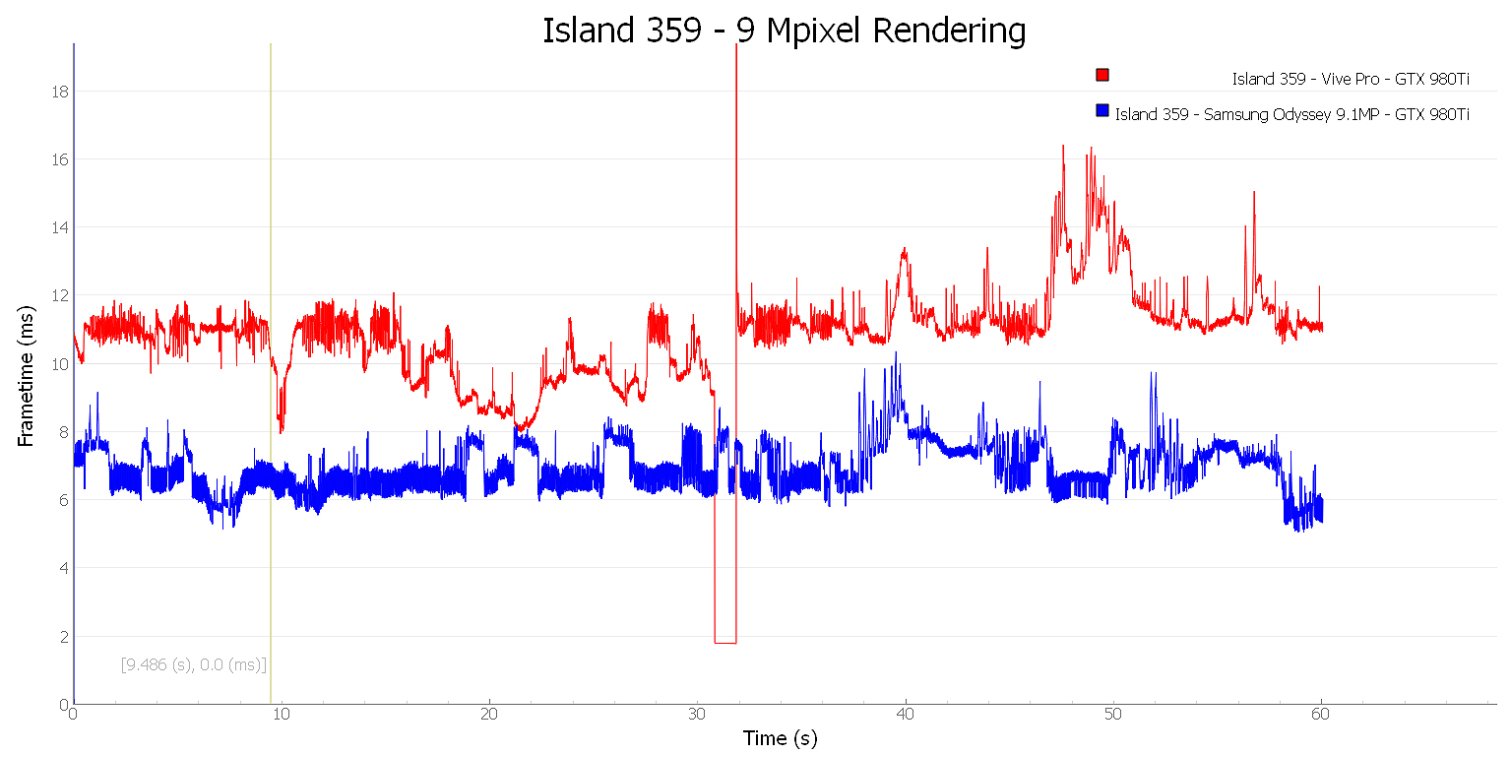
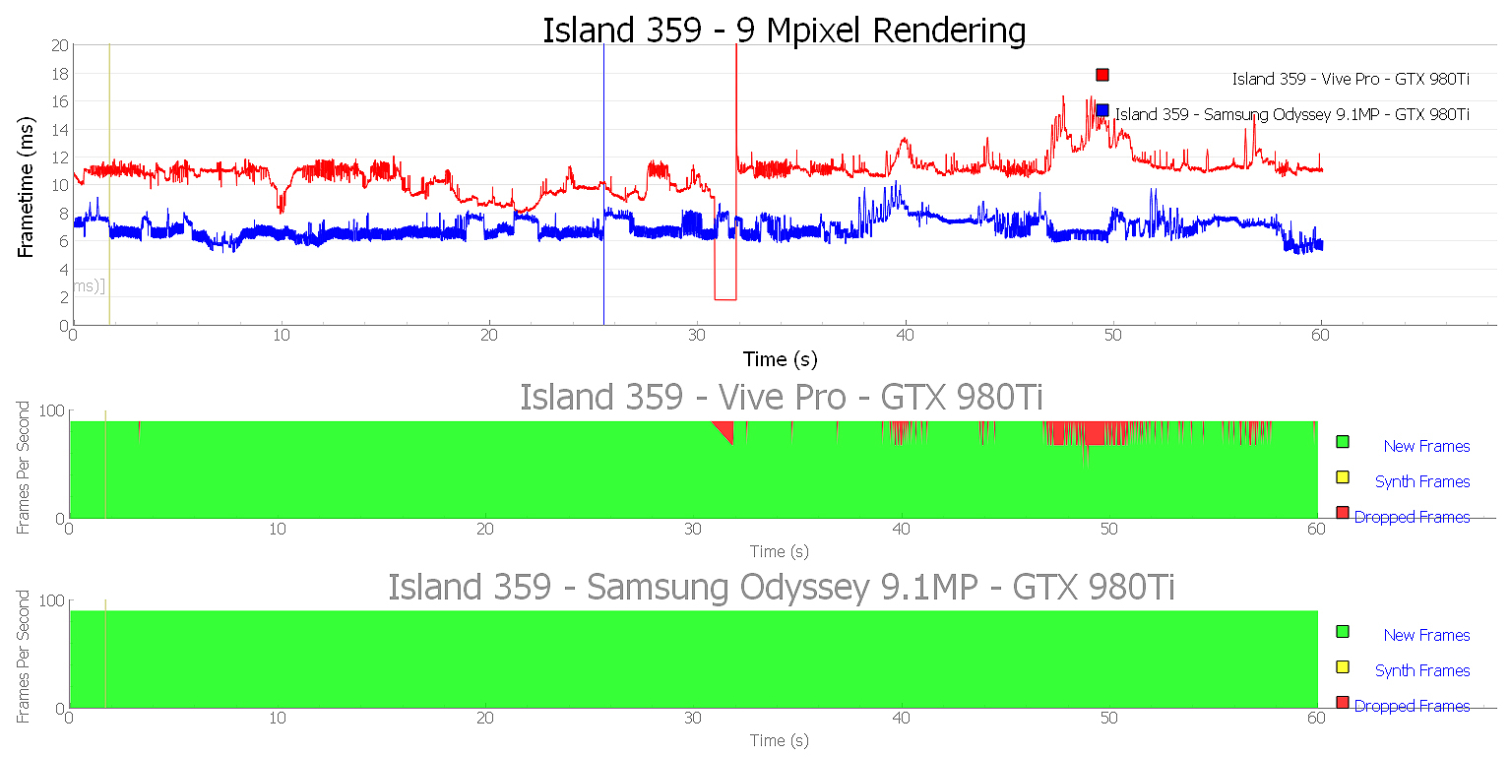
Faced with the added strain of rendering another 4 megapixels per frame, our GTX 970 fell flat on its face when we ran the Vive Pro off it. The GPU dropped virtually every second frame and delivered frame times in the mid-20ms range.
Predictably, the GTX 980 Ti handled the workload with much better results. However, the previous-generation halo-GPU still struggled to keep the frame rate up to par. The first half of our benchmark was buttery smooth, but the last 30 seconds started to get a little rough, and the GPU started dropping frames. It appears our GTX 980 Ti’s Kryptonite is Island 359 with High settings on a Vive Pro.
Current page: HTC Vive Pro Performance Analysis
Prev Page How We Tested the HTC Vive Pro Next Page The HTC Vive Pro: Final ThoughtsKevin Carbotte is a contributing writer for Tom's Hardware who primarily covers VR and AR hardware. He has been writing for us for more than four years.
-
ingtar33 well glad the screen door effect is discussed, somehow that's left out of many of these VR display discussions, as anyone who's actually used one for 5 minutes will tell you it's the biggest problem you'll face in VR for the most part.Reply
Good news on the design improvements and resolution improvement. Shame that god rays are still an issue. Seems like we're still a generation or two on this tech before it becomes something viable for the mainstream. -
jfkeenan There are several VR solutions available at a variety of price points. I wish people would stop complaining that HTC is offering a premium product. When I learned the news of the pre-order I was like, "Shut up and take my money!" I just got my tax return so this was a no brainer for me. Like Kevin said, if you can't afford a Mercedes don't be mad at them for making luxury cars.Reply -
kcarbotte Reply20852498 said:well glad the screen door effect is discussed, somehow that's left out of many of these VR display discussions, as anyone who's actually used one for 5 minutes will tell you it's the biggest problem you'll face in VR for the most part.
Good news on the design improvements and resolution improvement. Shame that god rays are still an issue. Seems like we're still a generation or two on this tech before it becomes something viable for the mainstream.
It's really not a big problem unless you're trying to do things that require reading text.
As someone who's put hundreds of hours in with the Vive, I can honestly say that screen door effect is not a real problem. It's just something that people like to complain about to give them justification not to adopt VR.
I won't deny that it exists. But I don't buy for a second that it's a real hindrance.
That said, if that's the biggest problem that you perceive, then VR is doing pretty good, I'd say. -
FreyjasChosen I'm with you, JFKEENAN. I pre-ordered the day it was available. I even bought the original HTC Vive because I needed the base stations and controllers (before the bundle was announced).Reply
I see a lot of complaints about the price tag of the Vive Pro, but no one's forcing anyone to buy it. I'm happy to pay for the best available product on the market. -
Giroro If HTC wants to charge a premium, then the device has to BE premium. There is a definite difference between "legitimately expensive" and "overpriced".Reply
At the end of the day, the Vive pro is still a tethered plastic headset that uses an inferior Samsung pentile display (forcing your system to waste 30% of its resources rendering subpixels that don't actually exists). Is the design a little better thought-out? sure.. that's how product iteration works. You change the design over time to improve quality and to decrease cost. What has HTC actually done here to justify the fact that they've more than doubled their asking price?
At the end of the day, nobody is going to pay "Lamborghini" prices for a Nissan Leaf E; not even one with particularly nice paint comfortable seats.
Of course, that's not a perfect analogy, because a used Nissan leaf is probably less expensive than a Vive Pro if you add in a computer powerful enough to deliver 90fps to such an impractical display. -
uglyduckling81 Kcarbotte can I ask which titles you have put the most time into?Reply
I've had a vive since launch but have used it less than 30 hours. I haven't found a game to put a lot of hours into. -
rhysiam The issue with your luxury car analogy is that in the case of VR, the product needs a vibrant software market to really succeed long term. When you buy a luxury car you're able to use a well-established road system that's developed over many years. That's not the case with VR. We have a classic chicken-and-egg situation where software developers are understandably nervous about investing heavily in VR experiences because the price of entry for VR results in a tiny potential market for their VR game/experience, while on the flip side, sales of headsets are being impacted by the limited games and experiences on offer. Lower headset sales means poorer economies of scale and higher per-headset prices to recoup the huge R&D investments, which just exacerbates the issue.Reply
Those of us (myself included) who really want VR to thrive long term do IMHO have some cause for concern with products like the Vive Pro that reinforce the fringe nature of VR and don't do a lot to entice the all-important software developers into the ecosystem.
Another threat to VR, and perhaps a bigger threat at that, is race-to-the-bottom headsets which compromise the experience. I know several people who have tried cheap, flawed VR experiences and written off VR as a whole. At least Vive is clearly marketing - and making strides to provide - a genuinely good VR experience.
I'm genuinely hoping for the day when I can pop on a wireless headset with 4K (or more) per eye and well-implemented foveated rendering and explore foreign worlds with interesting characters and complex stories. That's a platform that I would be more than willing to pay a lot of money to get access to. But getting there will require significant investment both on the hardware and software side. The Vive Pro headset is absolutely a step in the right direction from a technical hardware perspective, but is an (effectively) $1100 product right for the VR industry as a whole in the long term? I'm not so sure. -
uglyduckling81 I would say yes.Reply
Like you said a bad VR experience is horrendous and immediately turns you away.
When I got the Vive I only had a GTX 970 and it made me very sick every time I tried to use it. I was on the verge of selling it and putting VR into the non compatible with me section.
I took a different approach and upgraded to a GTX 1080 and haven't gotten sick since.
Turns out my hopeless travel sickness body is extremely susceptible to any frame time issues and the extra GPU horsepower did the trick. -
Ionlydothis The problem isn't that about offering a premium product. It's just that the Vive Pro IS NOT premium. It's exploitative. Minor improvements for a huge mark up but still the same critical flaws? Yeah, no thanks!Reply -
svx94 You can position yourself like Rolex or Mercedes of luxury market, they are built for "EXCLUSIVENESS"... that magic word won't do you any good in gaming market.Reply